
Бесплатный фрагмент - Conceptual Thinking in Piano Playing
Technique and Style
PART I. STYLE CHARACTERISTICS OF THE PERFORMANCE OF POLYPHONIC MUSIC OF THE 18TH CENTURY (J.S. BACH)
CHAPTER I. THE METHOD OF FORMATION OF AN IMAGE-REPRESENTATION WHILE WORKING AT TWO-PART POLYPHONIC WORKS. J.S. BACH
J.S. BACH. 15 two-part inventions
In order to create a mental image of a polyphonic composition, it is necessary to develop a complex of aural and motor sensations. The most important ones are as follows:
— feeling of parting in the pronunciation of each part simultaneously with the combination of motives into phrases and sentences;
— feeling of exact coincidence of parts by pulsation with simultaneous preservation of the timbre color of each part;
— sense of the integrity of the composition, which appears in the unity of the tempo-rhythmic and dynamic plans of the composition, the logic of the balance of its components.
On the basis of the above, a scheme of the formation of an artistic image of a two-part polyphonic composition has been drawn up: at each stage, aural and motor tasks are determined; the arrows show the interdependence and mutual influence of aural and motor sensations and representations, respectively.
SCHEME OF THE FORMATION
OF AN IMAGE-REPRESENTATION WHILE
WORKING AT TWO-PART POLYPHONIC WORKS
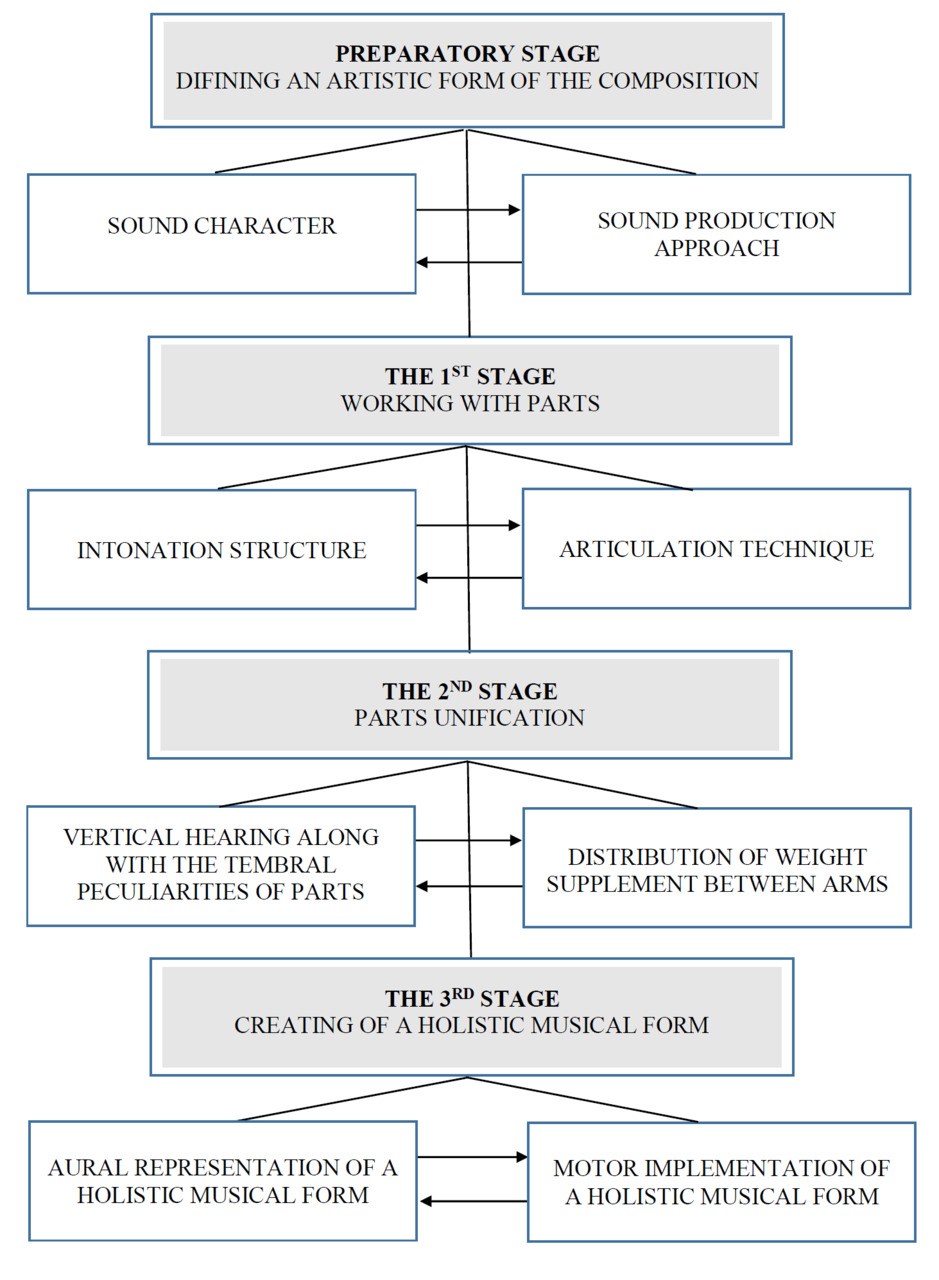
THE PRINCIPLE OF ENLARGING CONTROLLED FRAMES
The work at the formation of the image-representation is carried out according to the principle of enlarging controlled frames. This principle shows the path of transition from the representation of a single sound to the image-representation of the integral form of the composition. Control is understood as a mental representation of the sound, simultaneously with motor representations, including the sensations from interacting with the keys as well as touching the string with a hammer.
Let us illustrate the principle by means of an example.
In the C major invention, we initially control every sixteenth.

The pace is slow. It is necessary to count in sixteenths (in eighths, respectively, two counts). Before producing each sound, one should imagine it simultaneously with the motion.
Then they count in eighths and, accordingly, focus only on the sounds that coincide with the count

The next pace is with a quarter pulsation (this is the basic unit of the movement).

Sounds which do not fall into the pulsation are performed subconsciously, since they have already been fixed in the representation by the previous work. Further, the unit of control is a phrase. To do this, while performing it, you should keep in mind the first sound until the end of the phrase. Thus, a holistic sound is created in the representation.
The representation of the whole sentence, and then the section of the composition, is formed in the same way. At the second stage, the procedure remains the same, but two vertically coinciding sounds are presented simultaneously.
At the third stage of the work, the performer should form a holistic representation of the artistic form of the composition, which implies the ability to mentally reproduce the sound, feeling the whole process as a real performance. The composition is conceived by the performer in terms of the unity of its large sections, and the problem of the correlation of these sections is brought to the fore.
The inventions are analyzed in groups, in accordance with the most pronounced features of toccata, dance, or lyric-philosophical features inherent in one or another invention.
J.S. Bach is known to have rarely noted the character and tempo indications of his compositions. This is probably not the main thing in the performance of his compositions. Therefore, completely different interpretations of Bach’s compositions are possible, which nevertheless are equally valuable from an artistic point of view.
In this chapter, when considering each invention in detail, a variant of performance is indicated. (Before proceeding with the analysis of the inventions, it should be specified right away that it is more expedient to study the works of Bach from the Urtext edition, where the author’s text appears in the original, «unaltered» by editorial corrections and additions, as well as by editorial decoding of ornamentations and indicating articulations.) Nothing mobilizes the ear and the creativity more than the opportunity to create your own interpretation based on the strict composer writing.
In order to get the essence of Bach’s two-part compositions, you should study at least one invention from each group, and familiarize yourself with the rest.
Section I. INVENTIONS WITH FEATURES OF TOCCATA IN THE CHARACTER OF PERFORMANCE
This group includes the inventions C major, D minor, E-flat major, F major, A major. Their common features are as follows: a rather fast pace of performance, «motor power» in movement, bright dynamics.
§1. INVENTION in C Major, No.1
PREPARATORY STAGE
The best variant of the invention is its energetic and solemn sound.
This interpretation is suggested by the structure of the theme. First there is a bent for the IV degree, and then to the V degree in this interpretation, there is also heard the activity in the eighths:

A variant of both slower and more legato performance is possible. It puts great restraint and austerity to the music. In the proposed variant, a motor technique which CREATS a FESTIVE, VIVID SOUND WILL BE CLEAR LEGATO alongside with an active «picking up» movement of the fingertips. This movement is performed as follows: before the start of the sound production, the finger touches the key, and then sets the key in motion with a sliding movement «to oneself». The «weight supplement» of the arms should be used carefully so as not to oversaturate the sonority. Bach’s music is characterized by the strictness and clarity of sound. To obtain the necessary sonority, there should be a feeling that the arms are, as it were, supported by their own muscles from below (as if they were lying on an air cushion). The muscles of the back (under the shoulder blades) should always be active.
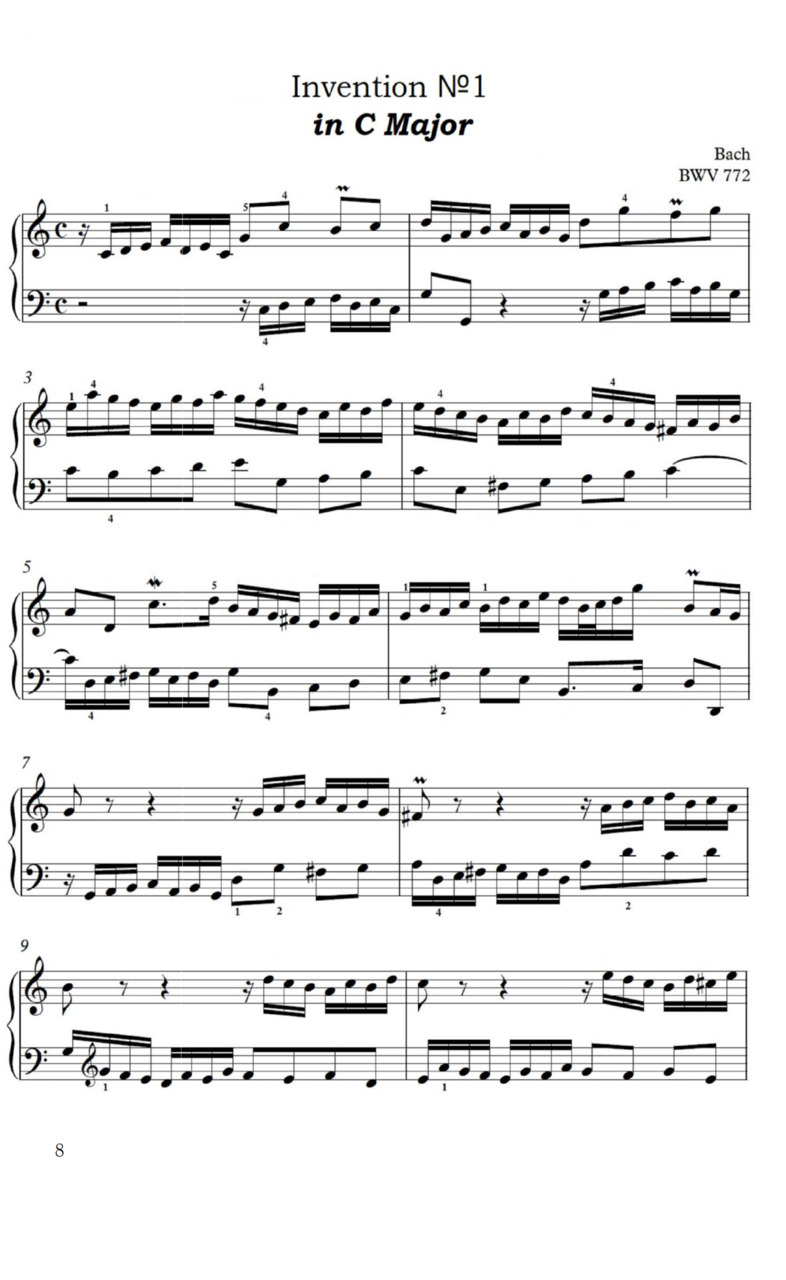
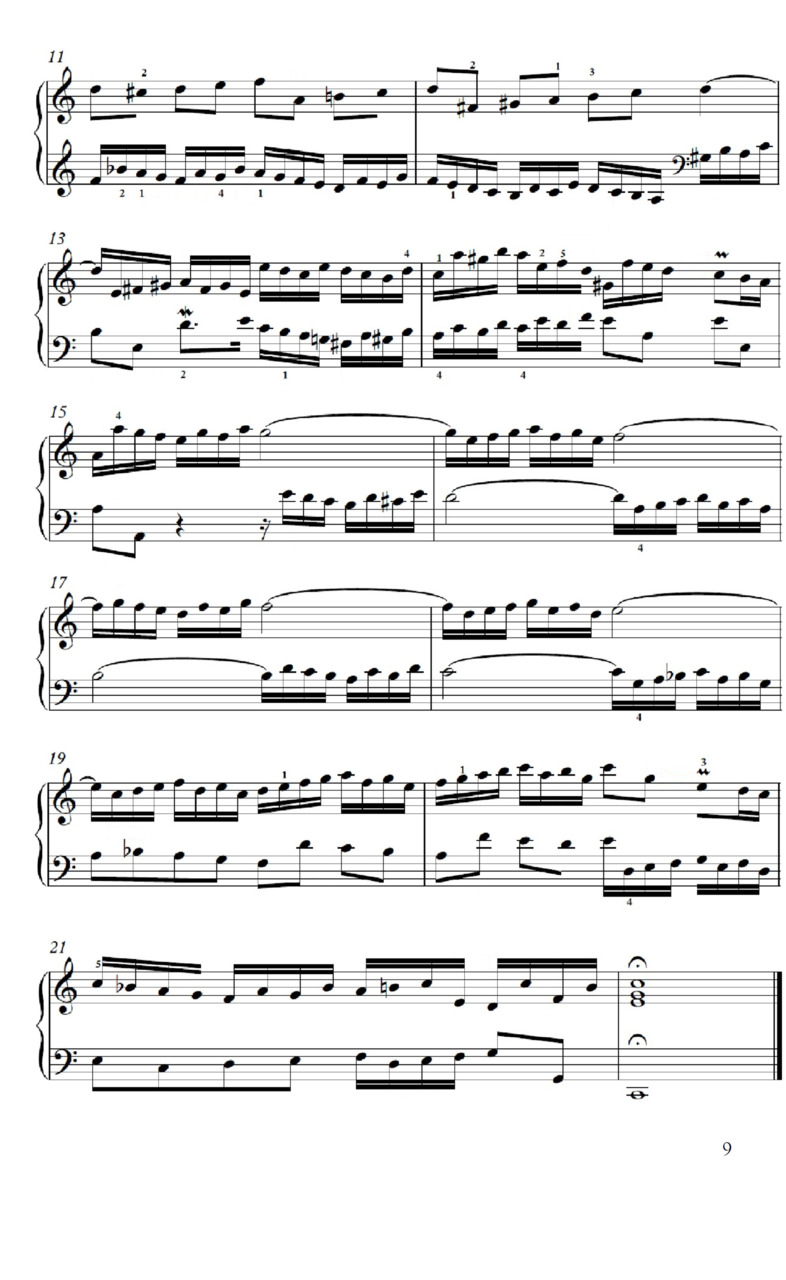
Three sections can be distinguished in the structure of the invention. The first one ends with modulation in G major, the second one ends with modulation in A minor.
STAGE I
The intonational structure of the invention consists of two types of motives — either it is an upward or downward movement in sixteenths (see the example of a theme), or motives of two eighths, moving in pairs in one or different directions (motives are determined by analogy with words in ordinary speech — one word has one stress, as a rule; in music, intonation stress is created by rhythmic pulsation). In this invention, the pulsation is in quarters. The motives are combined into phrases, and each sentence corresponds to a whole section.
Different articulations are chosen according to different motives. For example, the sixteenths are played legato and the eighths are performed non legato. A variant of the legato execution of cohesive motives of the eighths moving in one direction is possible, but in this case the legato of the eighths should be softer and more coherent than the legato of the sixteenths. This is the only way to create intonation diversity in the sound.
Articulation technique should differ in both aural and motor sensations. From the very beginning, the legato articulation is performed with actively acting fingers with a calm arm which maintains support through the palm into the strings, and the non legato articulation is performed by moving the arm on each sound.
STAGE II
As mentioned above, it is recommended to work at each part according to the principle of enlarging controlled frames.
There are two main points to note when combining the left and right hand parts. The first is the determination of the supporting arm. According to the scheme, this is called the distribution of the weight supplement between the arms: one hand should press the hammers more tightly against the string, and the other one should be more mobile.
In this invention, it is preferable to choose the right arm as a supporting one. It is easier to preserve the timbre uniqueness of each part by such a «motor division» of the parts; in addition, it greatly facilitates the coordination of the arms movements.
The second point is the concentration of attention on the vertical coincidence of the parts when working according to the principle of enlarging controlled frames. One should start working with pulsation in eighths, and then proceed to control in quarters.
STAGE III
The transition to the third stage presupposes that one is fluent in the text of the composition. At this stage, a special role is assigned to work without an instrument, both with the score and without the score.
The main task is to freely operate with aural-motoric representations within the framework of a holistic form. It is this that determines both the dynamics of the composition, and its tempo, here the nature of the performance is specified.
Motoric tasks are formulated on the basis of acoustic ones: the unity of movement must correspond to a united acoustic image. Such a generalizing movement is the direction of energy into the strings. It is possible to use the pedal, but one should press it shortly, on pulsation, or only on the first and third quarters. If difficulties arise in the execution of the ornamentations, it is necessary to control how accurately the first sound of the mordent is «captured», that is, the sound that falls into the pulsation.
When performing the invention from the beginning to the end, you should remember the initial sound of each section and keep it in your mind until you finish performing the invention, and when starting a new section, correlate its sound with the music already played. Thus, the dynamics of large constructions is indicated. For example: the first section is performed forte, the second one starts a little quieter than the first one, then the sonority increases, the third section is performed most vividly in terms of dynamics. Other options are also possible. It all depends on the individual hearing of the holistic form.
§2. INVENTION in D Minor, No. 4
PREPARATORY STAGE
In the sound of the theme of this invention, dramatic tension is heard. It is created by a leap downward by a diminished seventh.
More lyrical interpretation of the composition is also possible, with correspondingly a slower tempo and a soft attack of the sound, but a rather fast energetic movement with pulsation in a bar is preferable.
The necessary combination of toccata and a dramatic character with a certain softness and depth of sound can be obtained by using the technique of touching the keyboard with a straight finger, enhancing the feeling of the fingers moving «away from oneself» (as if one were opening the palm).
This technique is opposite to the technique of sound production in the C Major invention, where the active movement of the fingers «to oneself» was emphasized (as if one were collecting the keys in the palm of the hand).
The «weight supplement» of the arms should be used much more than in the first invention, and, respectively, the sound will be deeper and richer.
The invention has three sections. The first section ends in F major (bar 18), the second one ends in A minor (bar 38).
STAGE I
As it was in the C Major invention, here each section is just one extended sentence.
The main motives in the sixteenths:

in the eighths:

or in the sixteenths:

in the eighths:

Phrases usually consist of two or three motives.
The sixteenths should be performed legato, the eighths should be performed non legato. Since the movement of the eighths can be along the scale steps, and in tones of chords, and in leaps by an octave, it is possible to reveal the difference in these intonations by using varieties of the non legato articulation. Large intervals will be heard better with a more multipartite sound, small intervals will sound better if performed in an extended manner, close to the legato sound.
Working separately with the right and left hands according to the principle of enlarging controlled frames, it is necessary from the first stage to achieve comprehension of the sentence as a whole, that is, while performing it, keep the first sound in memory until the end of the section. In addition, you can analyze the development of the melodics, for example, mark the sequences (bars 7—8 and 9—10, etc.) in the parts of the right and left hands.
STAGE II
When two parts are combined, it can be difficult to play the trill. If one works at the trill itself correctly (i.e., imagining in advance only the sound that falls into the pulsation), then one can solve these problems. Following the recommended principle of working, it is necessary to control only the sounds that coincide in the right and left hands by the unit of movement (by the sixteenths, by the eighths, and then by the measure).
As for the choice of a supporting arm, at first it may seem that it is convenient to change the supporting arm depending on the fact what hand is playing legato and what hand is playing non legato. But this approach is misleading. This option fails to maintain the timbre of each part; in addition, there is a danger of paying too much attention to the theme. It will break the polyphonic character of the sound.
It is preferable to use the left arm as a supporting one, in this case the lower part will sound richer and it will bring the necessary seriousness and depth to the sound of the entire invention.
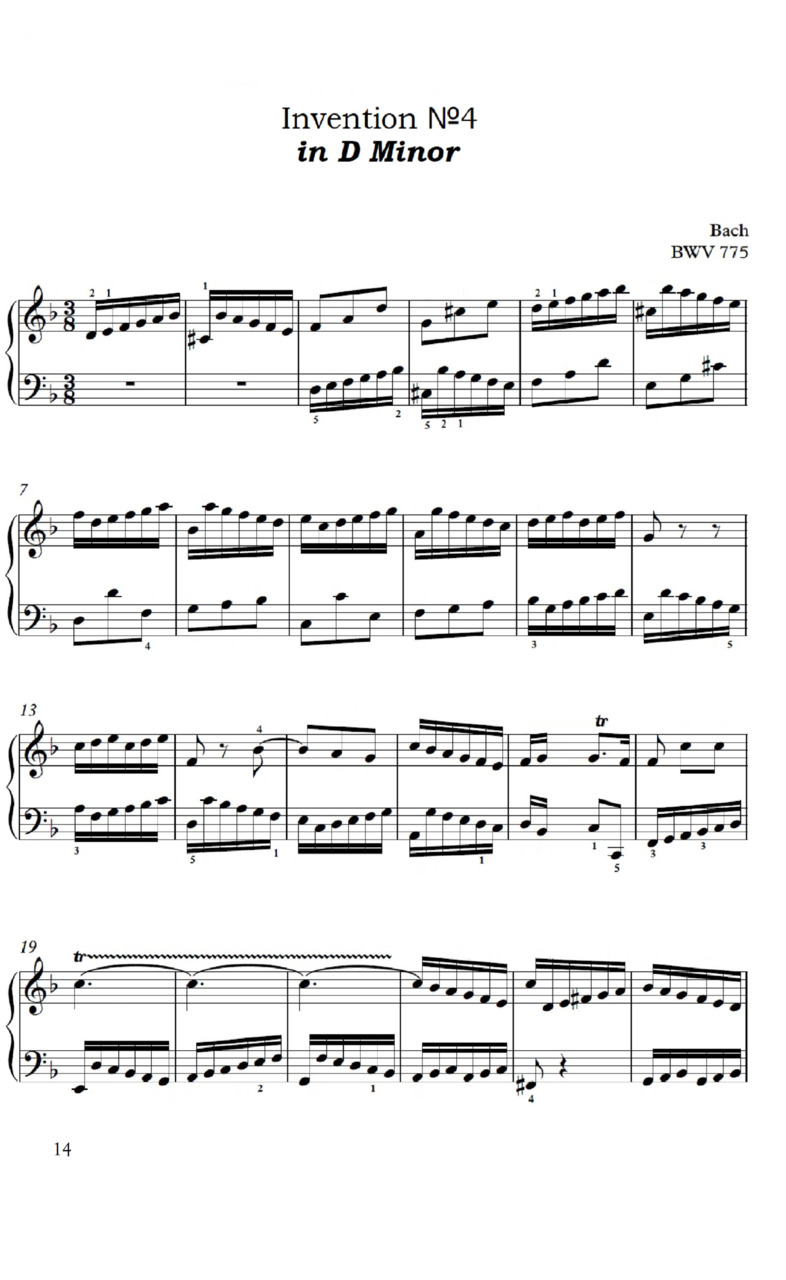
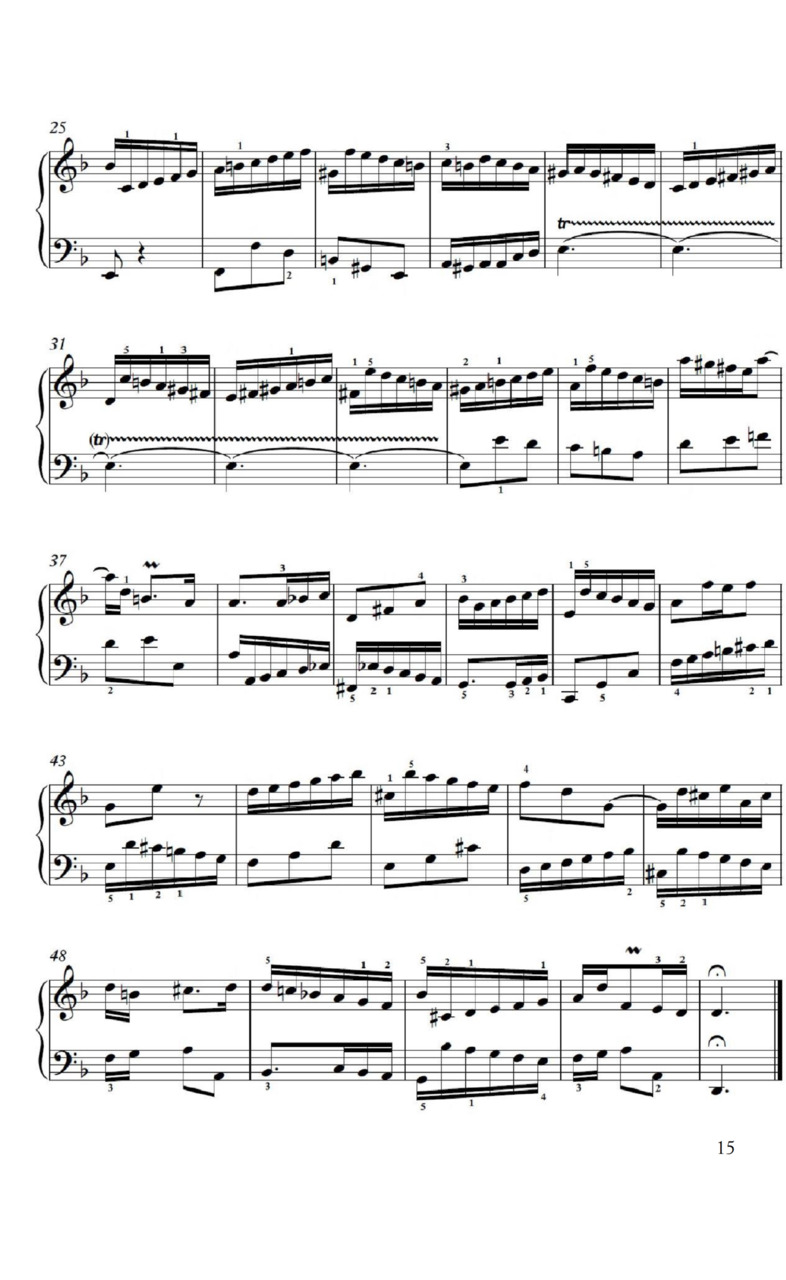
STAGE III
The dramatic and expressive character of the invention requires the use of vivid dynamics. One should often use the nuance of the forte. But in order to avoid a monotonous sound one should correctly compose the proportion of the sections of the invention. The following version of the dynamic balance might be used: the first section is performed forte, the second one starts a little quieter (about mf), and in order to preserve its integrity, one has to make a slight increase in volume to the beginning of the trill in the left-hand part (bar 29). But here there will also be a slight decline in dynamics, followed by an increase towards the end of the section. The third section is performed most vividly in terms of dynamics.
This detailed description of the dynamic plan of the invention is given just as a variant of performance and there is no aim to impose the given variant. However, the aim is to demonstrate how the dynamics depend on the principles of the space-time representation of the sound image of the composition. One can use the pedal briefly only on the first count of the measure, in accordance with the nature of the pulsation.
§3. INVENTION in E-Flat Major, No. 5
PREPARATORY STAGE
This invention is joyful by its character. The mordents «splash with delight». The fingertips should be extremely sensitive. To attain this one needs to tighten the muscles of the palm.
The feeling of active pulsation in the arm (not only in non legalo, but also in legato) will help to create the necessary sound image. Easiness of the sound combined with pressure, swiftness, sharpness of a sound attack requires only partial use of the weight supplement of the arms (to play with the support of the arms with their muscles from below).
The composition consists of three sections. The first one ends in F minor (beginning of bar 16), the second one ends with modulation in E-flat minor (bar 27). At the end of the third section, after the completion of the theme, the last bar, which is a kind of extension, is added.
An interesting detail of the construction of the invention is the constant statement of the countersubject in parallel with the theme. Each part repeats what the other part has said, and in such a way, in a complete agreement, their conversation proceeds.
STAGE I
The intonation structure of the invention is complex and varied. The theme in its complete statement is a sentence (4 bars), the sentence consists of four phrases.
The motives that make up the phrase are to be determined based on the pulsation (the unit of movement is a quarter). Various motives are in abundance:

One should not be confused with the fine fragmentation of the melody, most of the motives are naturally and firmly united into phrases, that is, what happens in ordinary speech with words. It would never occur to anyone to utter each word distinctly, separating each word from the rest by caesura. But understanding what is being said creates the lucidity of the expressed thought. The motive structure of the countersubject is as follows:
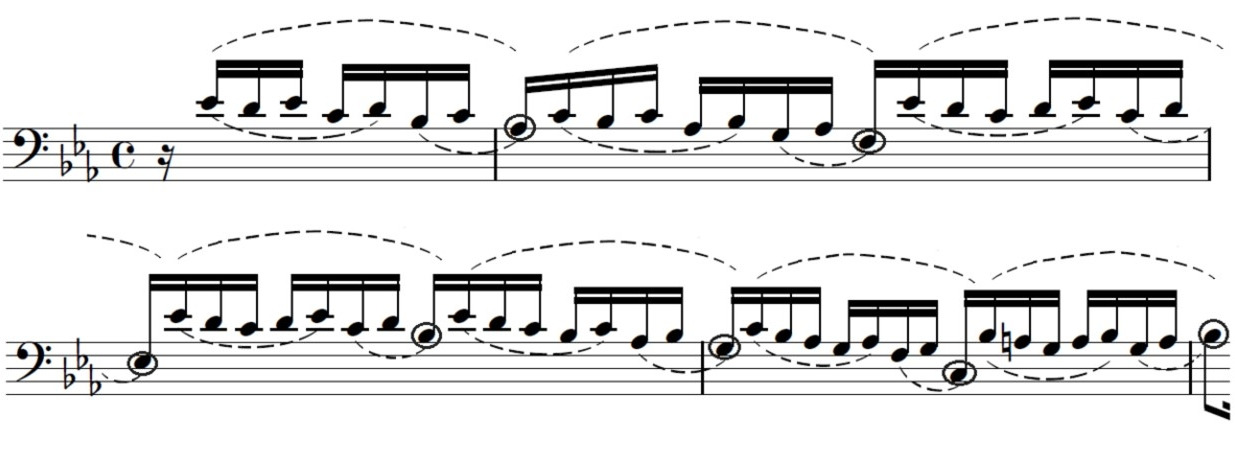
The fusion of two motives can be considered a small phrase. These «phrases», also merging, form a sentence, and the endings of the phrases, the lowest sounds, create a hidden polyphonic part. When mentally working at combining the sound, it should be conspicuous.
A variety of motives requires a variety of articulation technique. The sixteenths of the countersubject (both in the left-hand part and right-hand part) are best played with a clear finger legato, quickly grasping the key with the tip of the finger. As for the theme, there is a lot of room for initiative. It is only necessary to remember that the articulation is not an end in itself, but a way of identifying certain features of each motive.
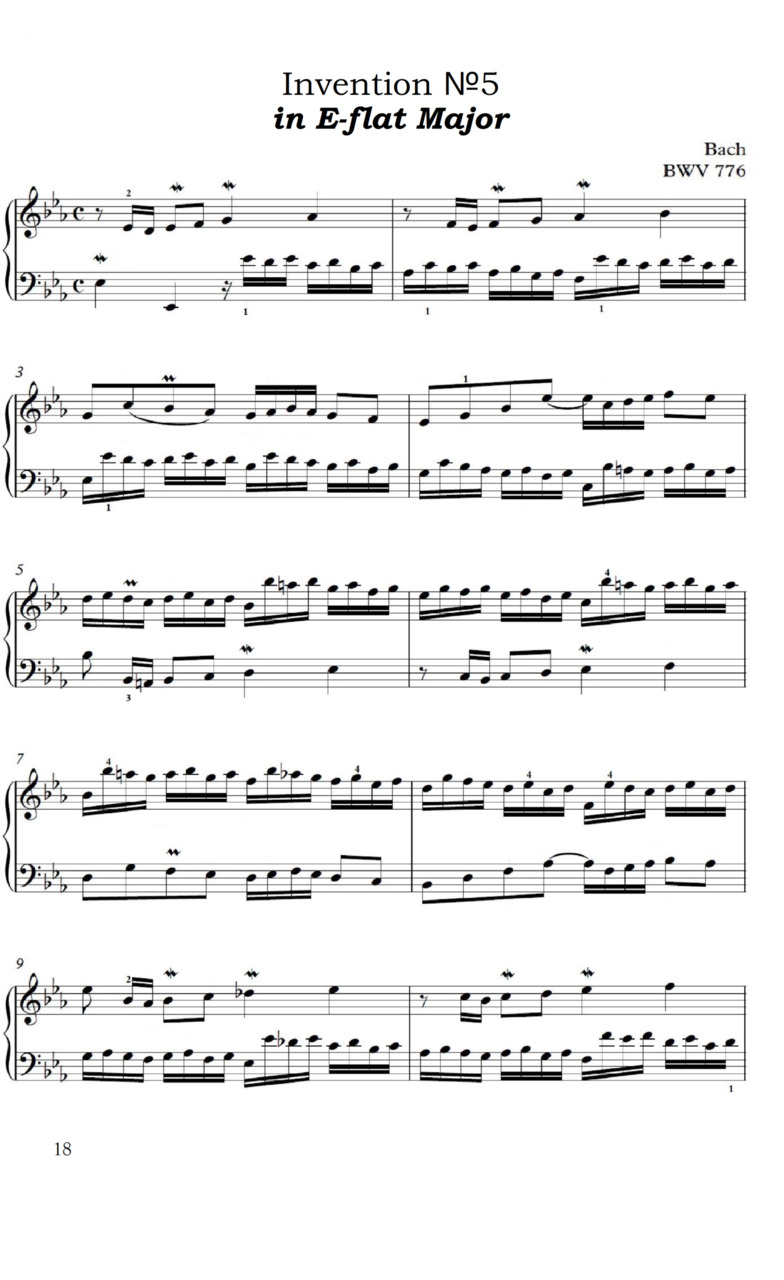
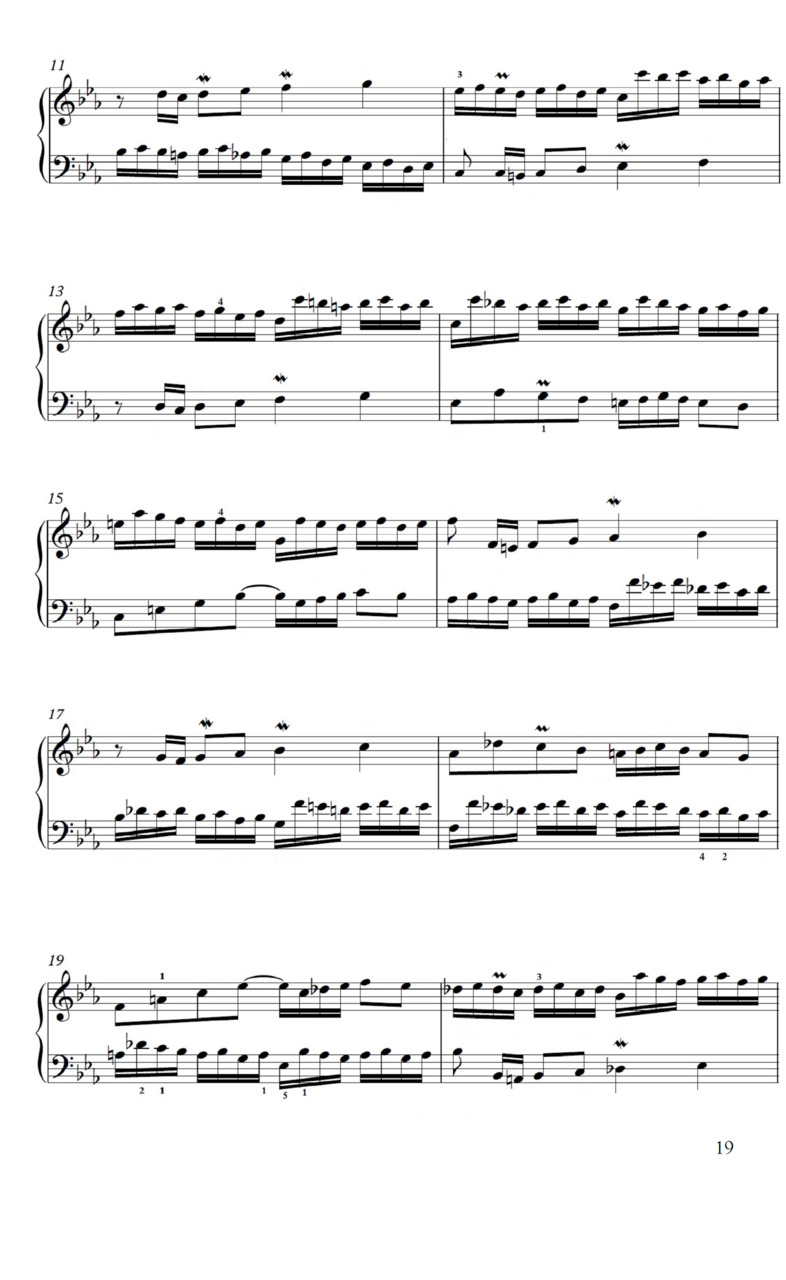
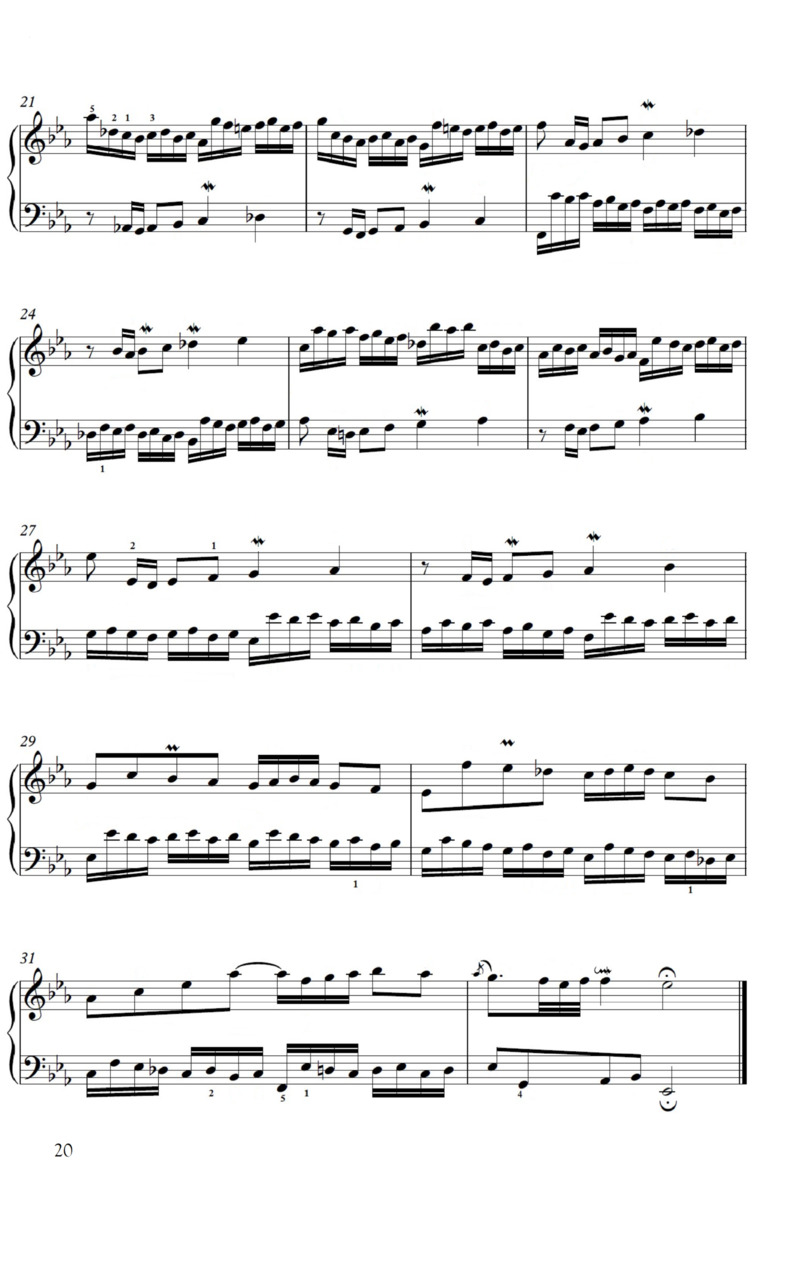
For example, if one plays the first bar of the theme with a certain articulation (in this case it doesn’t matter, if it is legato or non legato), the difference between the «overvoising» of the E-flat sound from the below and the rapid ascent to A-flat almost disappears. If one plays the first three sounds legato, and then plays non legato, and besides emphasizes the difference in the aspiration of pronouncing the motive «F-G» («F» should be performed almost staccato) with calm confidence in the pronouncing of A-flat, the theme revives and transfigures.
STAGE II
In the invention, two variants of the distribution of the weight supplement of the arms are possible. One of them is to constantly feel the right arm as a supporting one, and the other option is to change the position of the supporting arm depending on where the theme is. The first option is preferable. It is best to work not at the whole section at once, but to work at each sentence and start with control of the eighths at a slow pace. Only having learned to hear in advance two coinciding sounds one can move on to control by quarters, and then one should move on to a whole phrase and sentence.
To improve coordination of the motions one should constantly control the active work of the fingers in legato and the movement of the hands for each sound in non legato.
STAGE III
When performing this invention, there is a risk of falling into monotony, almost etude-like sound. One can avoid this by means of thorough work in order to create a holistic image.
Keeping in mind all the statements of the theme in different tonalities, it is much easier to feel the difference in their colour, character, and thus create a unity in the diversity of sound.
Purely technical difficulties may arise when executing the invention at the proper pace due to the richness of the texture and almost the absence of pauses. It is important to remember about the need to switch attention at the third stage of work from small motor sensations to the feeling of repose in the arms, support in the palm and the general direction of energy into the strings. At the same time one should not forget about the activity of the back muscles.
If it is difficult to perform all the ornamentations, it is possible not to play some of them. The pedal is used shortly: on «one» count and «three» count.
§4. INVENTION in F Major, No. 8
PREPARATORY STAGE
The decisive character of the invention is indicated by its beginning — active, ever expanding leaps in tones of F major triad to the top — the tonic. The second half of the theme is a descent along the same tones, but «filled» with sixteenths.

The invention consists of two unequal sections. The first section ends in C major (bar 12). In the second section, the main intonations of the theme develop freely with deviations in G minor, in D minor, B-flat major, and at the end there is a return to the key of F major.
Rhythmic definiteness, explicit volitional character, distinct sound, clear assertive articulation — these are the main features of the invention. Accordingly, the movements of the fingers should be active, «grasping» the keys. The weight of the arm should be used carefully; assertiveness should not turn into carelessness.
STAGE I
A peculiarity of the intonation structure of this invention is merging of the phrases and stringing them one on top of the other. The section, in fact, becomes one developed sentence. If one takes a quarter as the basic unit of movement, the motives line up as follows:

In the fragments where the same movement is repeated in the sixteenths, the motive structure is as follows:

In similar fragments pay attention to the latent two-part texture (bar 19):

Two layers of intonation clearly emerge in the sound of the invention. The first one is the movement in the eighths, as a rule, these are leaps at rather large intervals (they begin with a third). The second layer is the movement in the sixteenths, either along the scale steps, or «rotating» on the spot. To bring character to these two types of movement will be possible using clearly defined articulation distinction. The eighths should be played non legato, the sixteenths should be played legato.
STAGE II
At the second stage it is recommended to start working at a very slow pace. It is also recommended to consider the eighth as the unit of movement, and in those fragments where the movement goes along the sixteenths in the right-hand part and left-hand part, it is possible to take the smallest notes value as a unit of count.
One’s attention should be focused on the simultaneous hearing of coinciding sounds. It is very important that each part retains its own timbre colour, and the sound of the grand piano resembles a combination of two different instruments of an orchestra. How to achieve this is recounted below.
After you have mastered the execution of the invention at a slow pace, it is recommended to move to a medium tempo, and then it is recommended to move to a faster tempo with pulsation in quarters. When playing all these variants, one should focus on the simultaneous hearing of the sounds that fall into the pulsation (i.e, on the count «one», «two» and «three»).
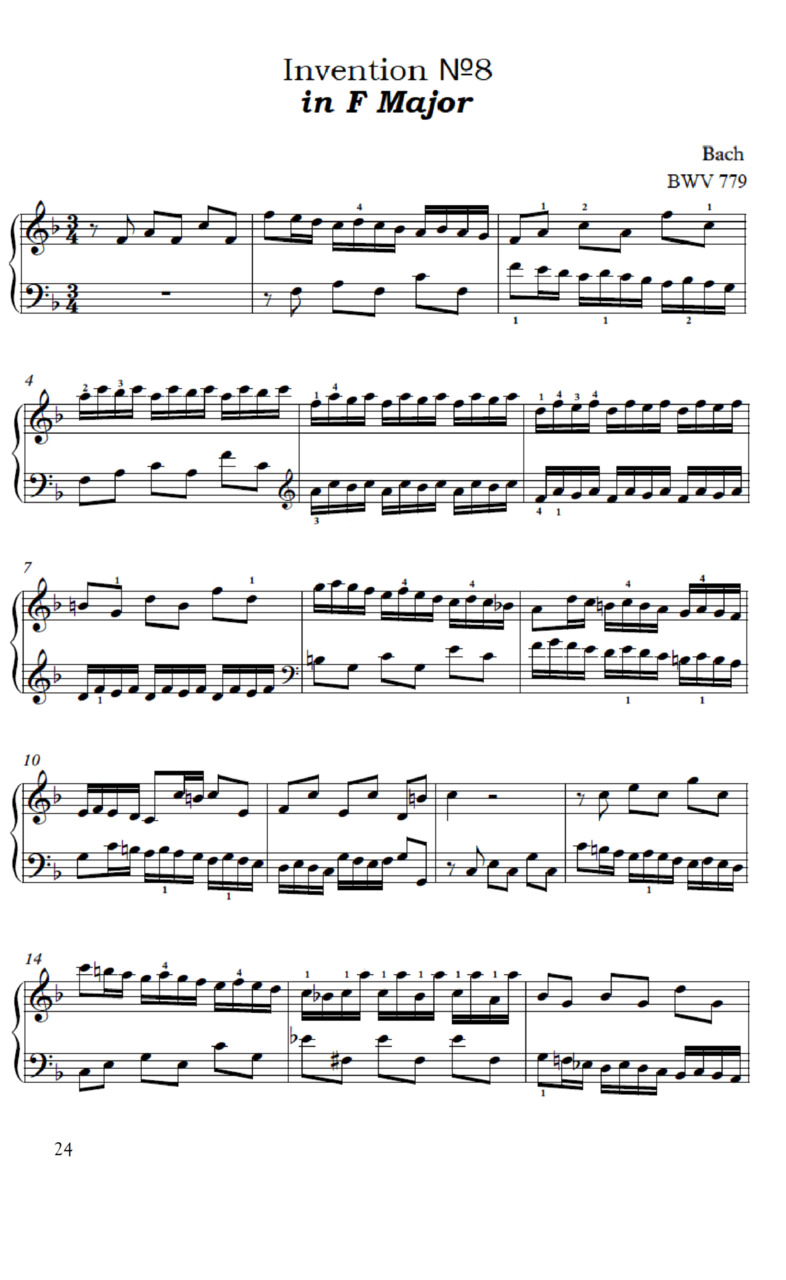
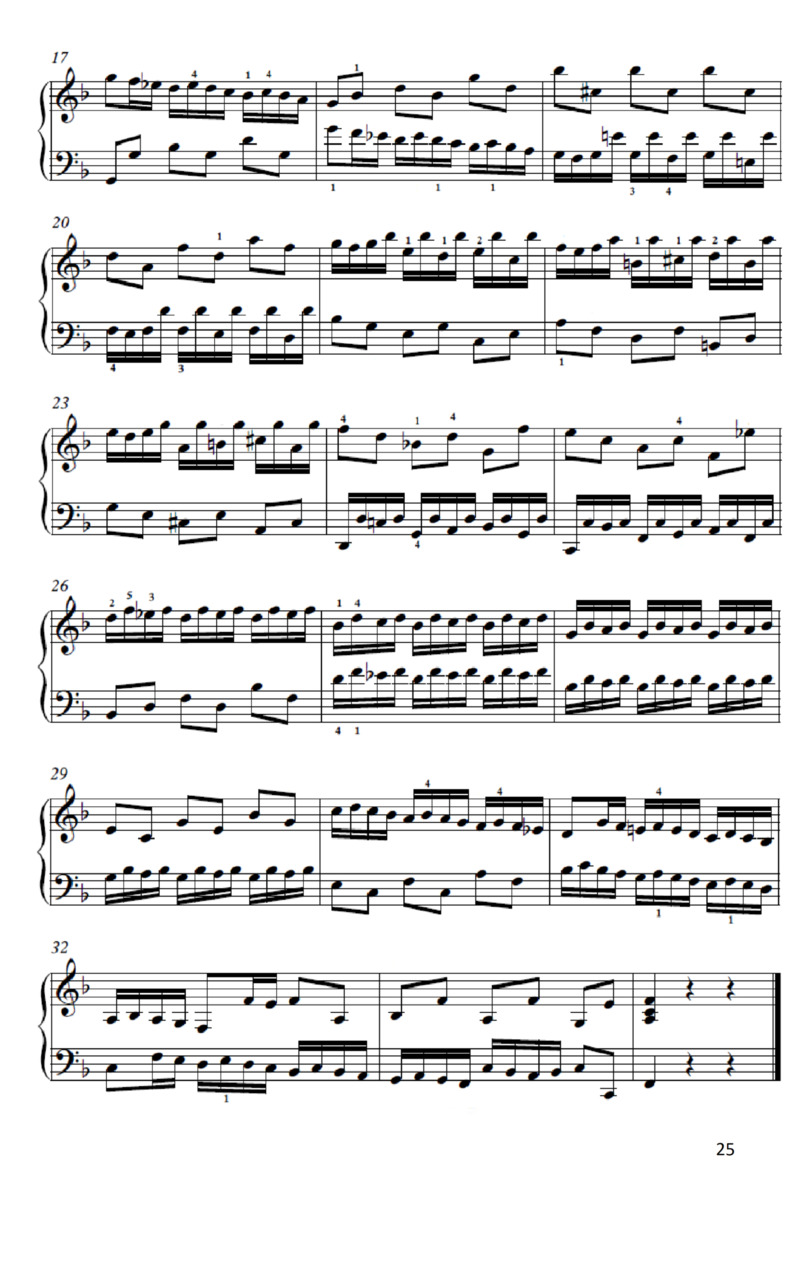
Accurate execution of articulations will help to provide different timbre when uniting the parts. As a rule, if there is legato in the right hand, then there is non legato in the left hand; and vice versa. The exceptions are the fragments with parallel movement in the sixth. It is simple to separate motor sensations in the arms while executing different articulations: in non legato the arm is working, in legato the arm does not rise, but the fingers are working.
In the parallel movement, unequal distribution of weight supplement of the arms will help to reproduce different timbre colour of sound while executing the same articulation. One needs to immerse one arm in the keyboard more, and to lighten a little the other arm. To choose the best variant of performance is possible only after listening to both variants of execution.
STAGE III
Moving on to the third stage of work at the invention, it is necessary to pay more attention to working without an instrument: try to imagine the sound of the invention in details, mentally playing it. But one should remember that along with careful listening to each note, the task of uniting musical speech into a complete thought comes to the fore at this stage. Therefore, when performing the invention, both in sections or in whole, it is necessary, as it were, to create an arch between the first and last sounds of the construction. Uniting the sounds in mind will reveal the most convincing dynamic plan of the performance of the invention.
When working at the artistic form of the composition, one must achieve calmness in movements; one should constantly control only those sensations that help to unite musical phrases, namely, one should check the activity of the back muscles and the feeling of the direction of the energy to the strings. It is necessary to remember that movements not only affect the sound produced, but can also create a certain mood of the listeners. Poor appearance, unsteady seating at the instrument, even the position of the legs, everything matters for the aesthetic perception of music.
Using the pedal should be short, for example, only on the count of «one» followed by a quick release of the pedal.
§5. INVENTION in A Major, No. 12
PREPARATORY STAGE
It is a brilliant, sunny play. In contrast to the similar one, also joyful and happy (E-flat major invention), there is breadth and chant in it, arising from the arpeggiated «overvoicing» of the tones of the chords.
According to the character of the sound, the touch on the piano keys should be different from the one used in the E-flat major invention. One can use the weight of the arms more boldly, and the fingers should «stroke» the keys, starting from the position of an almost straight finger. The attack of the sound extraction should be longer as well.
There are three sections in the invention. The first one ends at the 9th bar with modulation in F-sharp minor, the second one ends at the 14th bar with a return to A major.
A variant of the interpretation of the invention which emphasizes the features of dance in it is possible.
STAGE I
When determining the motive structure, one should focus on the maximum clarification of the pitch structure of the melodic.
For example, the sixteenths can be pronounced in several ways:
Bar 1

Bar 8

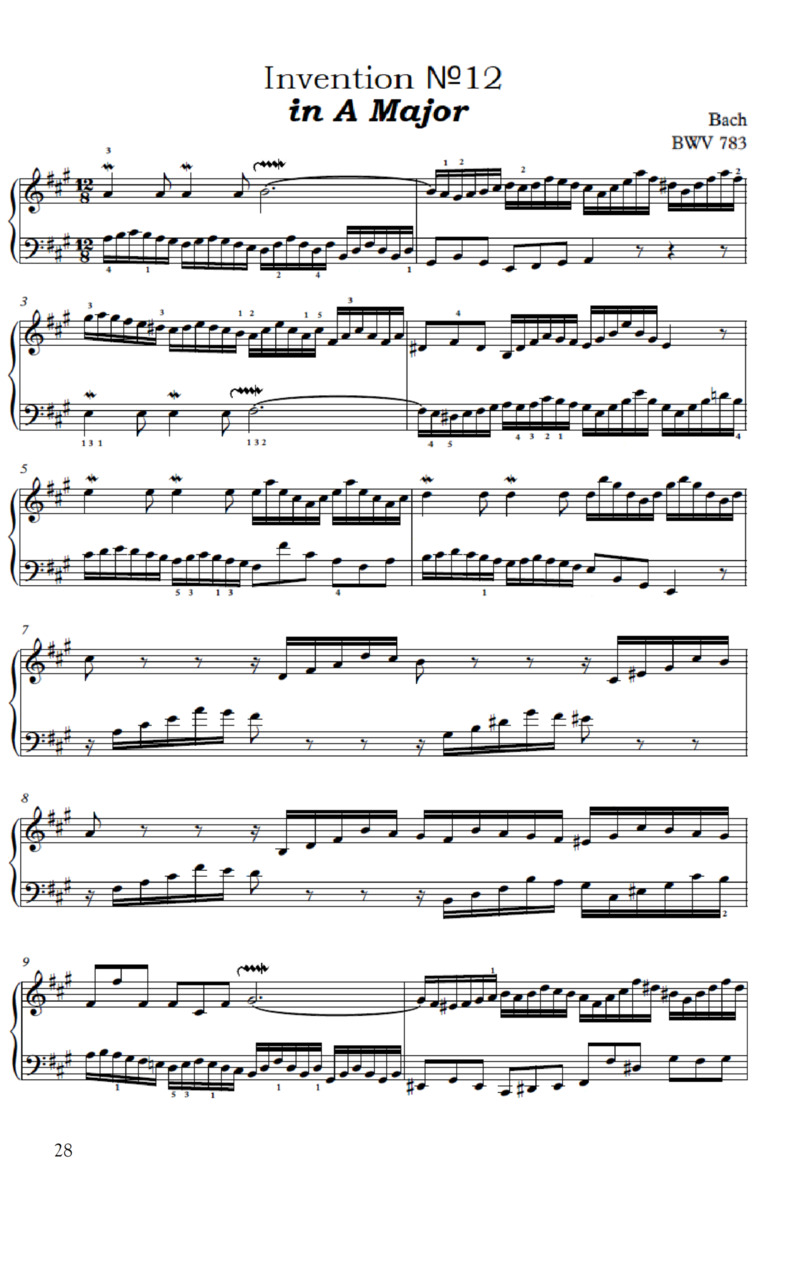
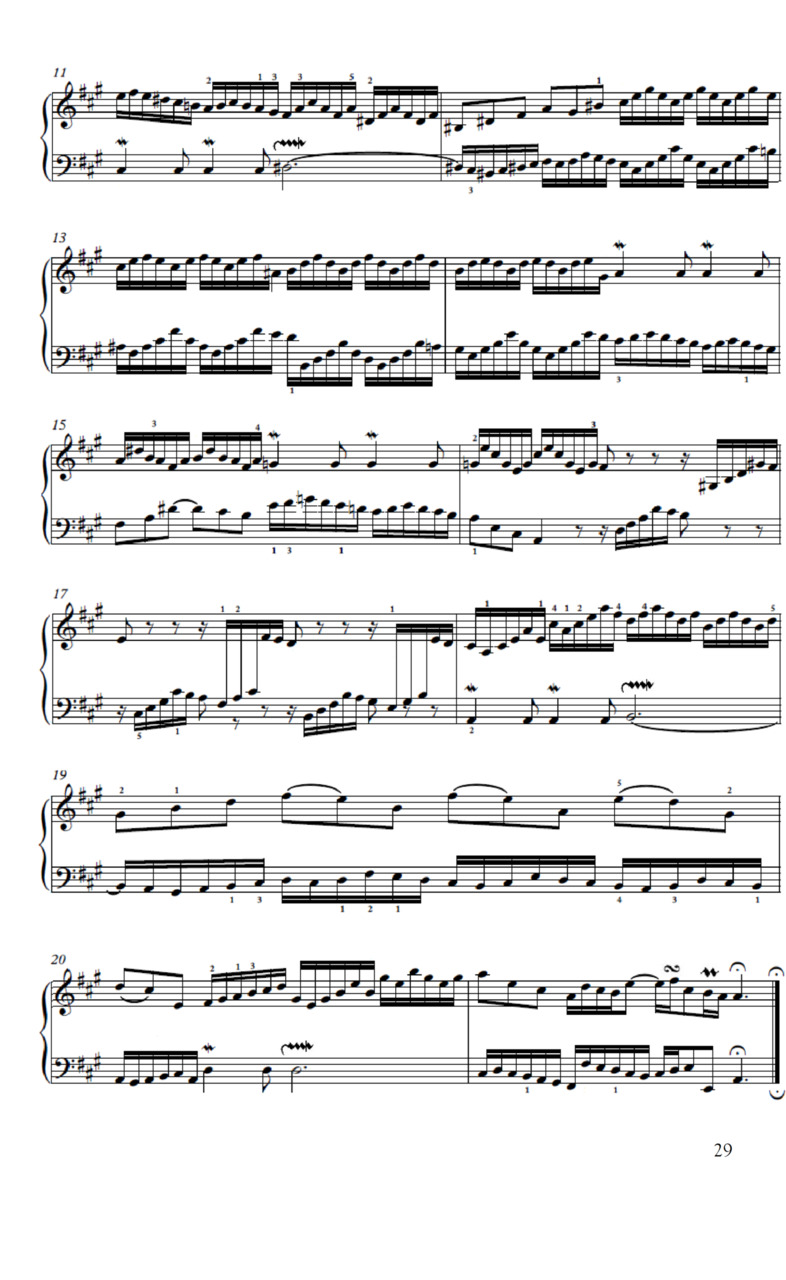
In bars 12—14, a hidden part appears (both in the right hand and left hand), these are the repeated highest and lowest sounds.
The sixteenths should be played legato, the eighths and quarters should be played non legato. At the end of the invention (bars 19, 20), there are author’s slurs, they emphasize the need to start each motive from the third eighth note and give softness to the descending passages of seconds.
STAGE II
It is preferable to make the right arm a supporting one and maintain this position until the end of the invention, regardless of changes in articulations.
The most difficult fragment, from the point of view of coordination of the motions and creation of the necessary sound, are bars 12—14.
It should be noted that the hidden parts, that have been indicated above, do not coincide in the parts of the right and left hands. In the left-hand part, this is the second sixteenth note, and in the right-hand part, this is the third sixteenth note.
When playing with two hands, performers often make the following mistake: they leave off a long sound ahead of time (here long sounds are quarters). To prevent this, while working at a slow pace with pulsation in eighths, one should hear how the same sound coincides with the changed sounds in another part.
STAGE III
Emotional openness, brightness, temperament in the performance, all these features are the qualities which are necessary for performing this composition. There is no need to be «shy» here.
Forte dominates in dynamics form of the performance. Piano is justified only in bars 12—14 and in the fragments of «rarefied texture», where parts exchange cues. These conclusions can be reached by mentally creating integrity in the sound of the invention.
Using the pedal is minimal. Long difficult ornamentations can be replaced with shorter ones, but they should sound clear, sonorous and proud.
Note: It is also possible to perform these inventions without using the pedal, but if one uses the pedal, it should be done very carefully.
Section 2. INVENTIONS OF THE LYRICO-PHILOSOPHICAL CHARACTER
This group includes the following inventions: C minor, F minor, G minor, A minor, B minor.
§1. INVENTION in C Minor, No. 2
PREPARATORY STAGE
The invention has the features of the canon. It is tender sadness. The fingertips gently and carefully touch the keys, and the hammers also gently touch the strings.
One should feel as if the fingers were playing directly over the strings. In order to achieve this one needs to stretch the muscles of the palm to the fingertips. One also needs to use the muscles of the arms («air cushion» from below).
To get a clear, transparent, enchanting sound one should check the activity of the back muscles. It will help to avoid overstraining the muscles of the arms.
The invention includes three sections. The second one begins with the 13th bar, the third one, a small one, begins with the theme in the upper part (bar 23), it is possible to consider these lines as a final section.
STAGE I
The definition of phrases and sentences should present no difficulty. But real creative work is required when analyzing the motives. The endless number of versions of the interpretation of the text occurs to a thoughtful performer.
For example, the theme can be read in several ways:

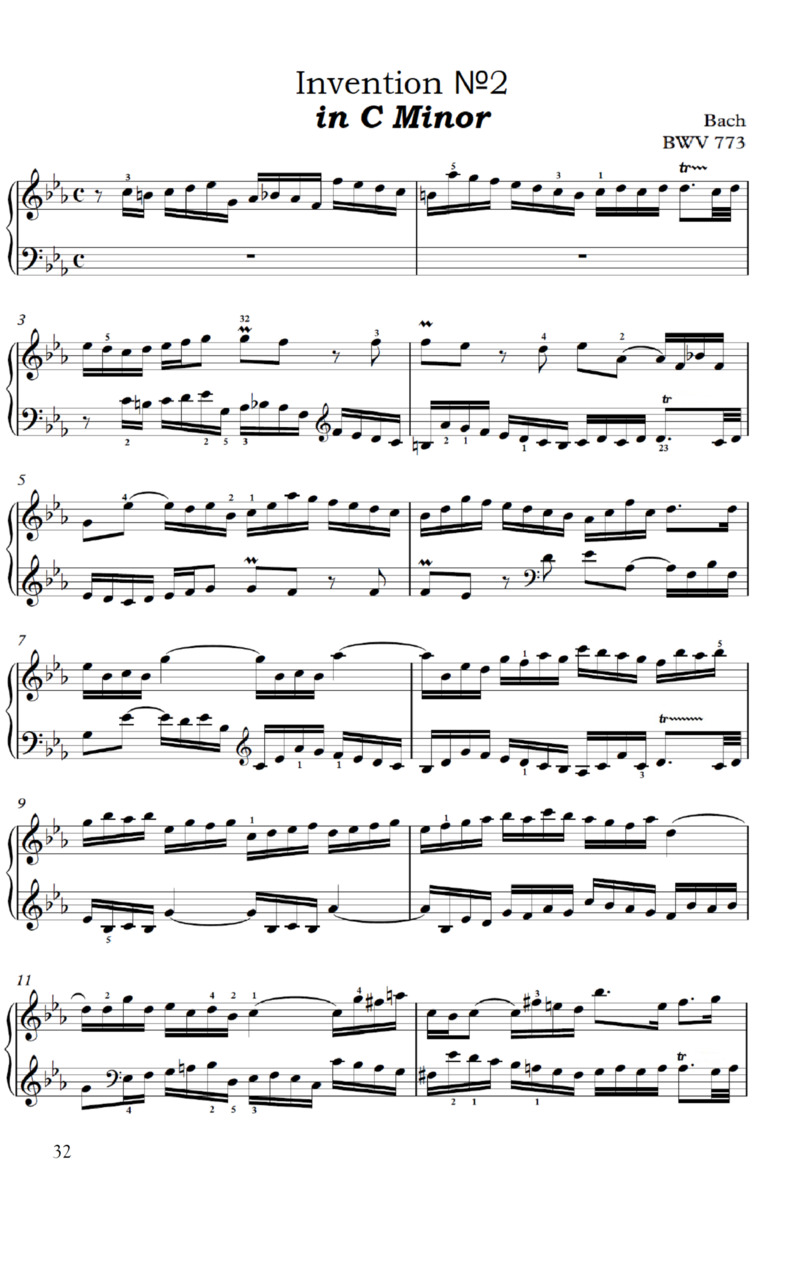
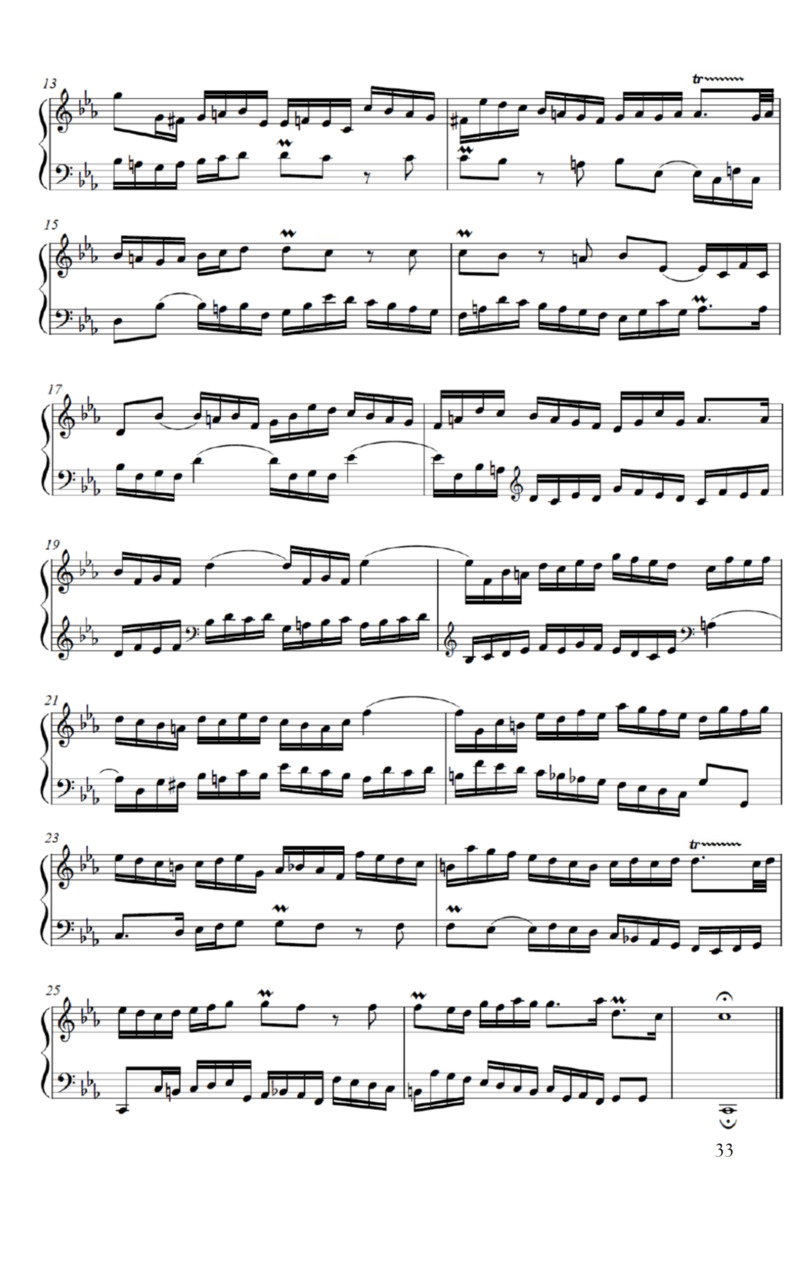
The variant indicated by the broken line emphasizes the softness of the melody, while the variant indicated by the solid line enhances its inner agitation. Here are only two variants, but a different version of the theme interpretation is also possible. Only those who have learned to hear and understand the difference in the various motives will be able to solve the mystery of J.S. Bach’s music.
The invention is performed mostly legato, but the eighths and the beginning of the phrases should be separated non legato.
STAGE II
A special difficulty arises when uniting two parts which are performed with the same articulation and which have the same notes value. Equal sounding of both parts can be achieved only by giving them different timbre colour.
It is easier to do this, apparently, if the left arm is a supporting one. Greater immersion in the keyboard makes it possible to reveal low overtones, to make the lower part slightly richer, however, the upper one will glow, become cleaner and more transparent.
One should pay attention to the end of the invention, where the lowest sounds in the left-hand part appear. In the right-hand part, one should pay attention to the highest sounds. In addition, it is very important to mentally stretch out the sounding eighths and quarters which performed legato.
When working according to the principle of enlarging controlled frames, it is recommended not to forget to play and think by eighths, this pace should be initial.
STAGE III
The choice of the tempo of the performance depends on the integrity of the sound of the theme, if the thought does not break in the mind presentation, it means that it is possible to create the unity of the sound of the part and the whole. In any case, the tempo should not be too slow. Dynamic gradations are moderate. They reveal when sounds are united mentally. There won’t be much contrast between the sections. Differences in dynamics will be created mainly due to the different timbre colour appearing in the lowest and highest registers.
The most striking sections in the dynamic plan are the end of the first section and the end of the invention. All the dynamic changes should be within piano.
In this invention, one can perform mordents, starting from the upper sound, in order to make the melodic line smoother. Using the pedal should be minimal.
§2. INVENTION in F Minor, No. 9
PREPARATORY STAGE
This is the most tragic of all the inventions. Its intonations, spanning large intervals, are filled with pain and suffering. Concentrated, deep and serious sounding requires that one should have mastered the technique of execution of the melodious «vocal» legato.
The predominant technic is the movement of the fingers «from oneself» (before the start of sound production, the finger touches the key, and then, gently straightening, it pushes slightly the key away from oneself). The arms should be flexible and supple so that the «support» of the arm muscles is almost unnecessary. The muscles of the back will hold the arms, and the hands will obediently follow the fingers so that the support through the palm to the strings remains.
The invention has two sections. The first section ends in C minor (bar 17); the second section returns to the basic key (tonality) in F minor, and this also includes the final section (from bar 29).
STAGE I
In this invention, one finds several author’s slurs, and they are different: by a whole bar, and by a quarter, and even by short slurs consisting of two sounds (bar 8). We will analyze at least some of them.
Bar 1:
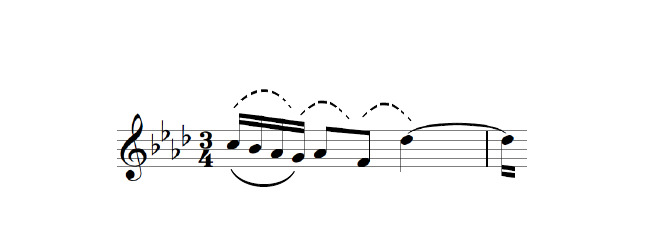
The slur shows that the sound «A-flat» should be produced separately non legato with the whole arm, although the motive begins with the sound «G».
The next motive consisting of two notes is also played non legato. There are a sufficient number of such slurs in the invention. In order to perform these slurs, one should produce the eighth with the motion of the whole arm. This approach will emphasize the duration of the attack of the sound in the pulsation.
Compare two similar bars:
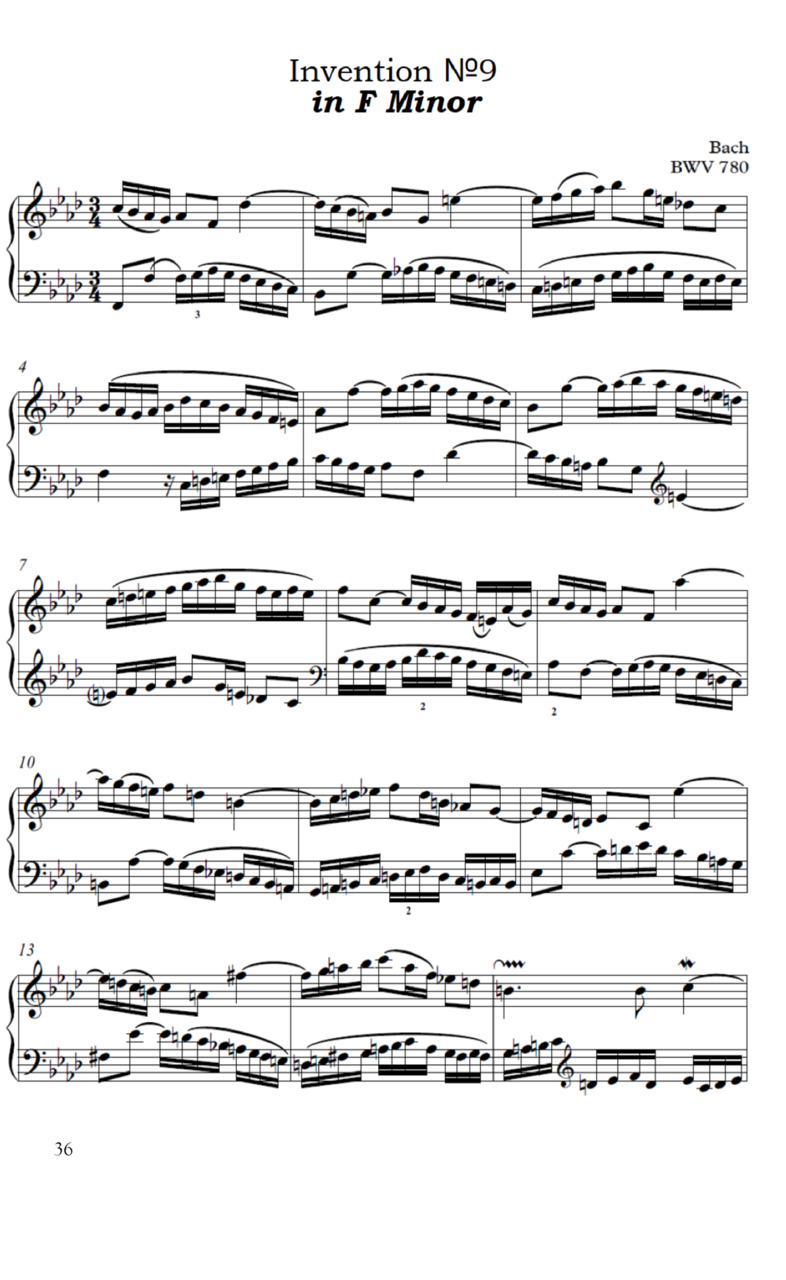
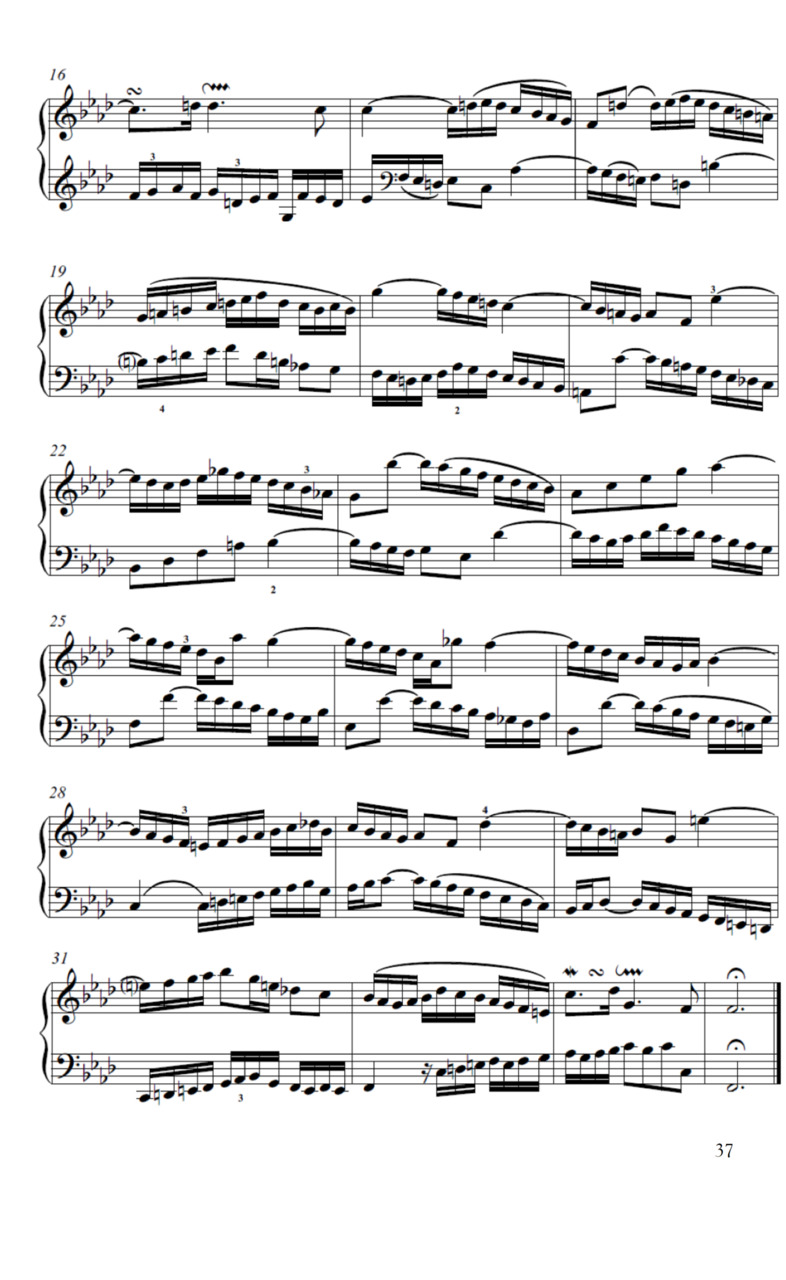
Bar 3:
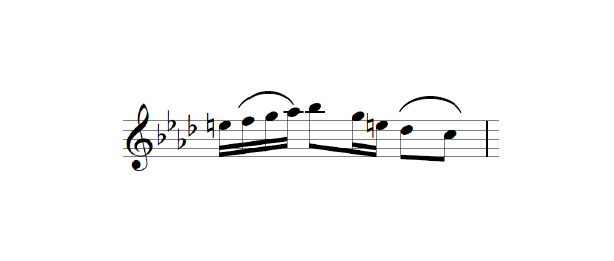
Bar 14:
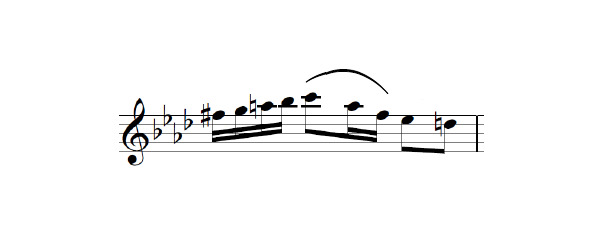
In the first case, the note «B» is separated from the note «G» by a small caesura, as if showing the unstable state of the reached peak, and in the second case, on the contrary, the note «C» stretches even more, as if reluctant to leave the conquered highest point of the invention. Here is the culmination of the first section of the composition.
STAGE II
The most difficult thing in this invention is to convey the easy «conversation» of the parts along with a clear hearing of all the words-motives.
At the point where the sixteenths sound simultaneously, there is a risk of «adjusting» the motives of one part to the other one and pronouncing both in the same way. Carefully control the accuracy of articulation and remember to check the difference in the support of the arms. It is better to make the right arm more mobile. Working according to the principle of enlarging controlled frames, it is imperative to start with pulsation in eighths, although while playing at the usual pace there will be the movement in quarters. Particular attention should be paid to the long slurred notes. As a rule, one always forgets to hear the slurred sound before playing further. In addition, such a sound must be dynamically produced so that it remains in a good vertical combination with another part.
STAGE III
It is always more difficult to create a unity of form in musical compositions when they are performed at a slow pace. However, it is especially difficult to do this when a thought inextricably passes through the entire section, and the section is quite long. First of all, you need to hear the combination of the sentences well (there will be three of them in the first section, each begins with a statement of the theme, bars 1,5,9).
This will make it possible to build a dynamic plan of the invention and choose the right pace at which it is possible to keep in mind the beginning of the idea until the end of the section. The integrity of the sentences has already been prepared in the second phase of the work. The second section is even more difficult. In fact, there are only two sentences in it (the first one lasts until the final section). It is better to start the second section with piano after the culmination in the first section. Then follows a long development of the theme intonation by means of sequences, wide leaps, long «singing» notes. And all this will lead to a reprise (bar 29). There are two ways to solve the problem of harmony of the form. One of them is intended to perform a dynamically brighter final section, and the other one is intended to climax on piano and to finish the composition quietly and mournfully.
It is an imperative to pedal the invention. But it is necessary to carefully listen to the sound, so that the part leading is not «clogged» by the pedal, the non legato articulation and all the caesurae in the motives should be clearly audible. If one finds it difficult to choose an option for the execution of the ornamentations, one needs to refer to the table of their decoding at the end of this chapter.
§3. INVENTION in G Minor, No. 11
PREPARATORY STAGE
The sound of the invention in G minor should range from a transparent and clear sound to a minor and melodious, deep one in F minor invention.
To give softness to the invention one should touch the keys with slightly bent fingers, followed by the movement «away from oneself». To obtain transparency and lightness of the sound is possible if the weight of the arms is not fully used. When playing, the arms seem to be supported by their own muscles from below. If in the F minor invention wide leaps gave it drama and tension, here the descending passages of the seconds create a mood of touching humility.
The structure of the invention is similar to the previous one (№9). It also has two sections with a reprise as the final section.
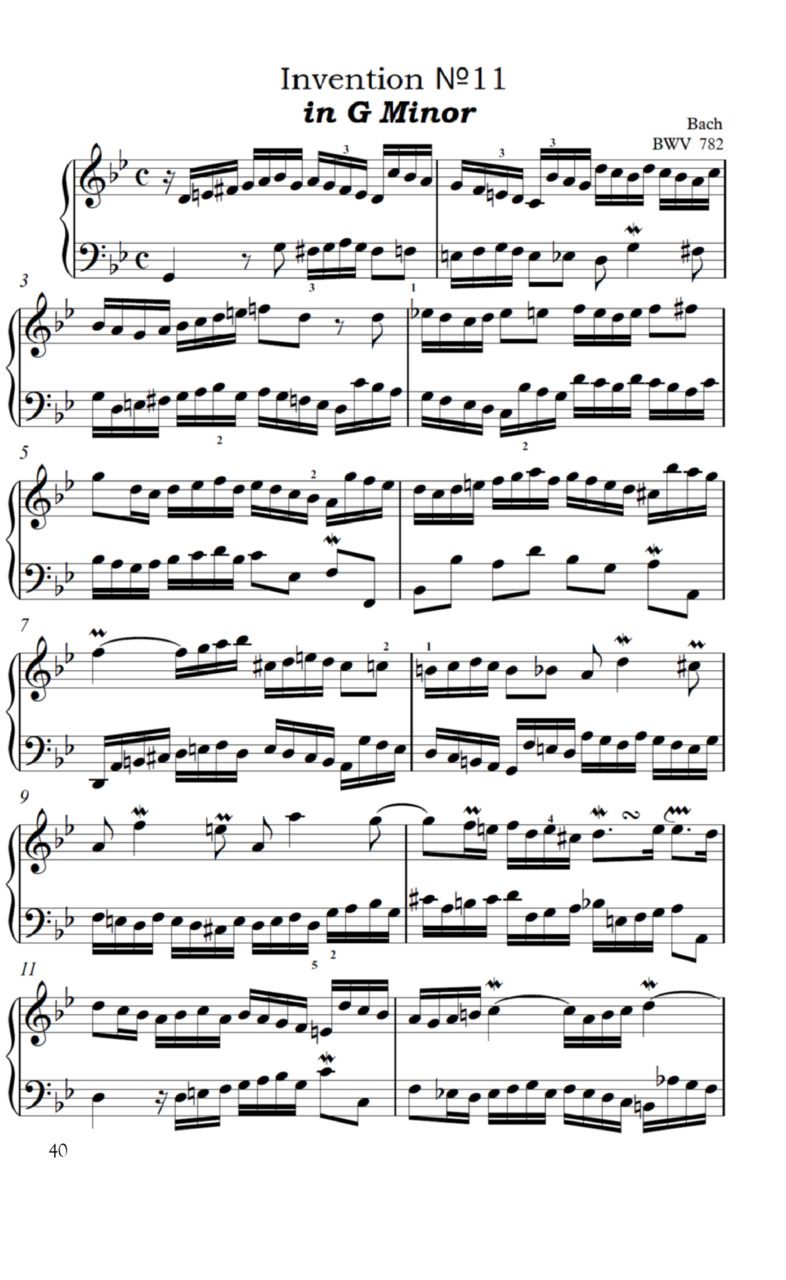
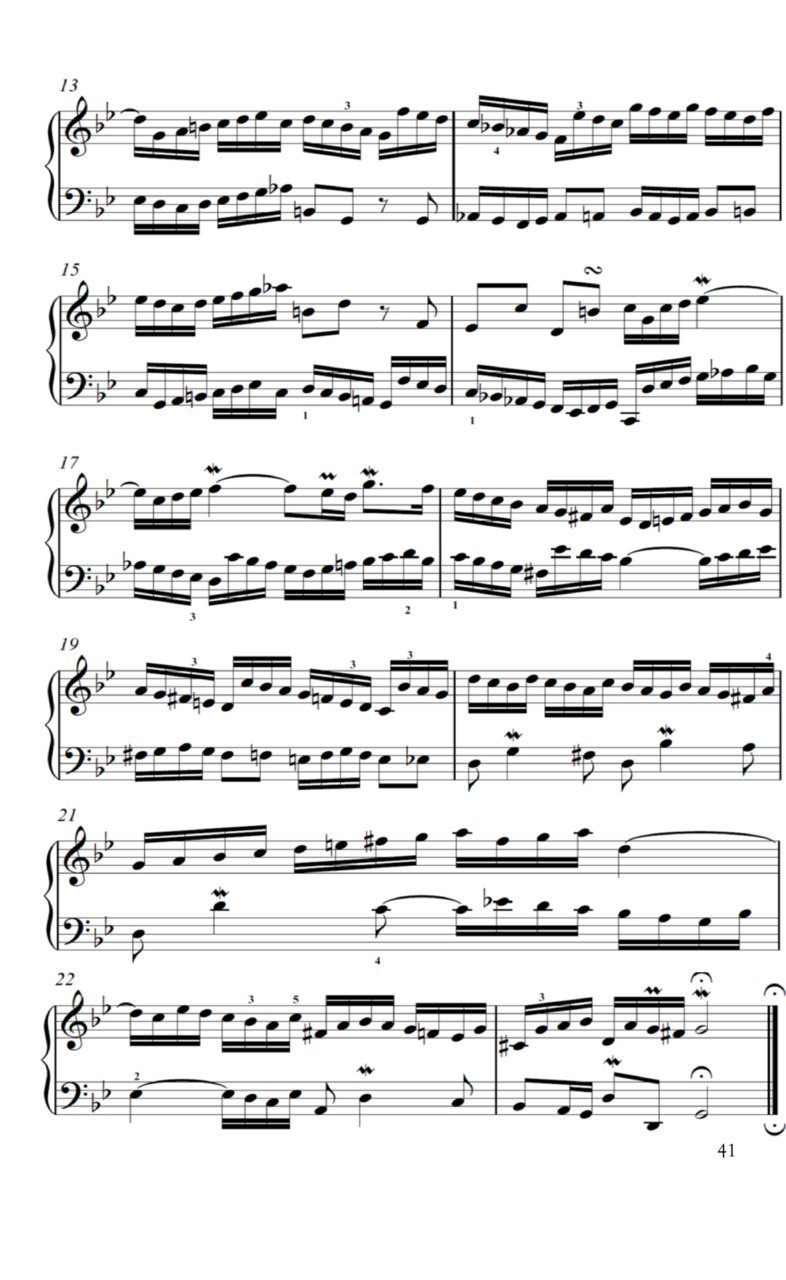
STAGE I
The peculiarity of the intonational composition of the invention is that the unity of the motives, phrases and sentences is greater than in the F minor invention.
The whole part is «pronounced» in one breath. The first section has two sentences (the first one ends in bar 7). The second section contains three sentences. The first one ends at the 16th bar, the second one ends at the 18th bar, and immediately without the caesura right from the second sixteenth in the upper part the final, third sentence begins.
It is very important not to miss a single melodic turn, or a single turn of thought, or a shade of intonation in this general movement. It is necessary to check and recheck how much this or that motive segmentation clarifies the thought.
In the continuous movement of the sixteenths, the richest possibilities of various ways of intonation are hidden:

The lower lines indicate motives, the upper lines indicate small phrases. You can consider the entire passage before the pause as one big phrase.
Understanding what is being pronounced gives liveliness and immediacy to the sound of the part and this helps to avoid monotony of the repetitive movement of the notes of the same value. There will be no special articulation variety here, the sixteenths are performed legato, the eighths are performed non legato. Still another thing that can be done is to play the eights at small intervals, so that small intervals will sound less separated than the eights at large intervals.
STAGE II
Everything said in relation to the invention in F minor also applies to this invention. It is better to make the right arm a supporting one.
It is recommended to work first on small fragments (about two bars each), then combine them into a sentence, and only then play the section as a whole.
STAGE III
Dynamically, this invention is much quieter than the F minor one. One should use the pedal very carefully and not often, preserving the transparency of the sound. It is better to not choose a very slow pace.
When creating a mental image, attention must be paid to the integrity of each section, which is especially difficult in this invention (as well as in the previous one).
As an exercise that helps to feel the unity of the development of a musical thought, you can use the following movement: simultaneously draw two circles with two arms in the plane in front of you, straightening your arms up and bending them at the elbows on your chest. For each section there should be one completed movement. The arms should move calmly and evenly and at the end of each section they should be placed and joined on the chest. When playing the piano, directing energy from the back muscles into the strings will be this unifying movement.
§4. INVENTION in A Minor, No. 13
PREPARATORY STAGE
In this invention, as in no other one, the harmonic basis is clearly visible.
If you look closely at the melody, you will see the movement of the parts according to the tones of the chords. Harmony is collected bit by bit — from four, eight sounds, and sometimes from sixteenths of a whole bar. From here comes the chanting of wide melodic turns.
To make the sound melodious and soft, play with straighter fingers, as if caressing and stroking the keys. For a movement on the keyboard to be uninhibited, the weight of the arm can be used more boldly.
The invention has four sentences, thus sections. The first section in A minor modulates in C major. In the second section, after some sequential deviations, modulation occurs in E minor. The third section is all based on diminished chords. The fourth section begins with a return to A minor.
STAGE I
The following motives are most common in the invention. Bar 1:
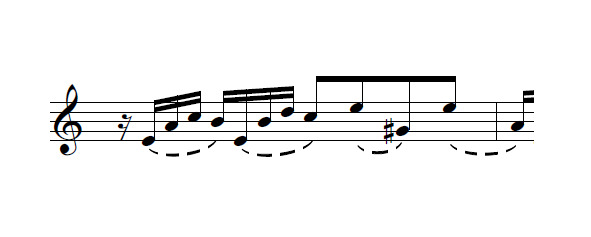
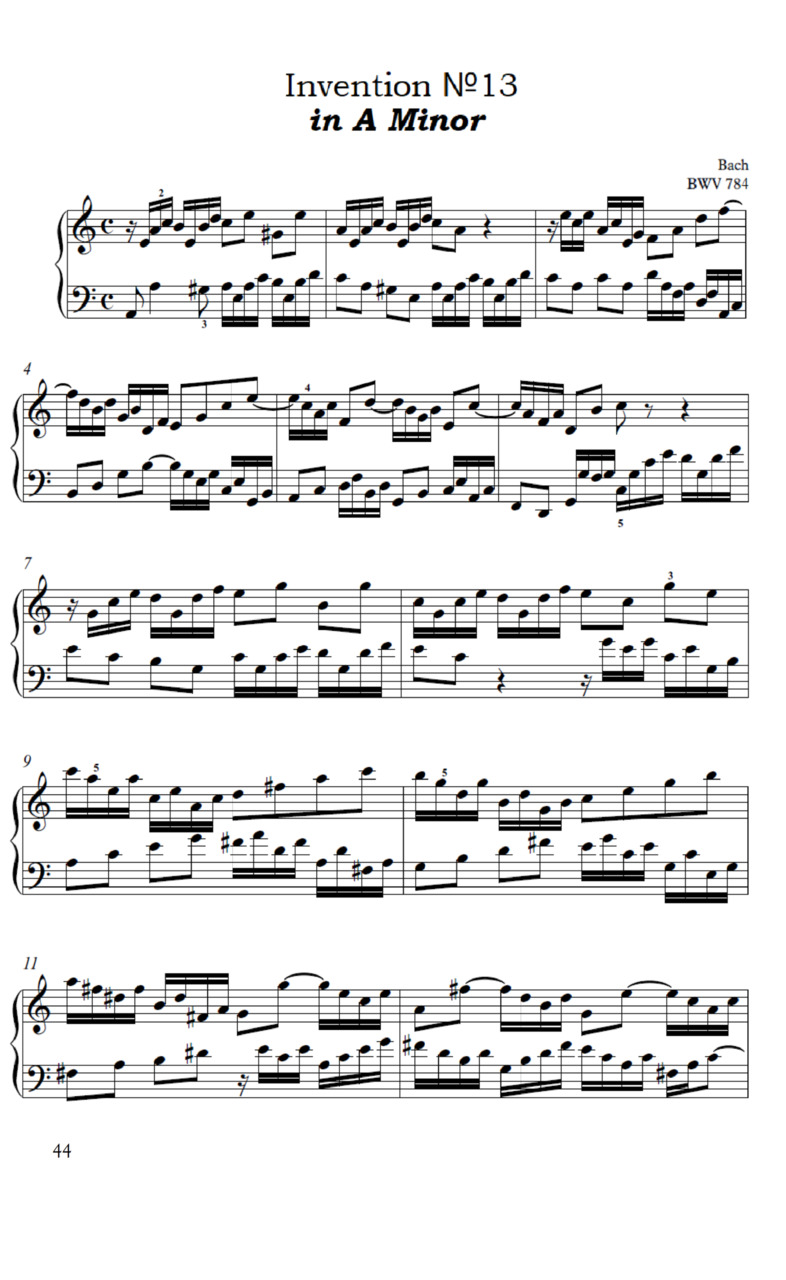
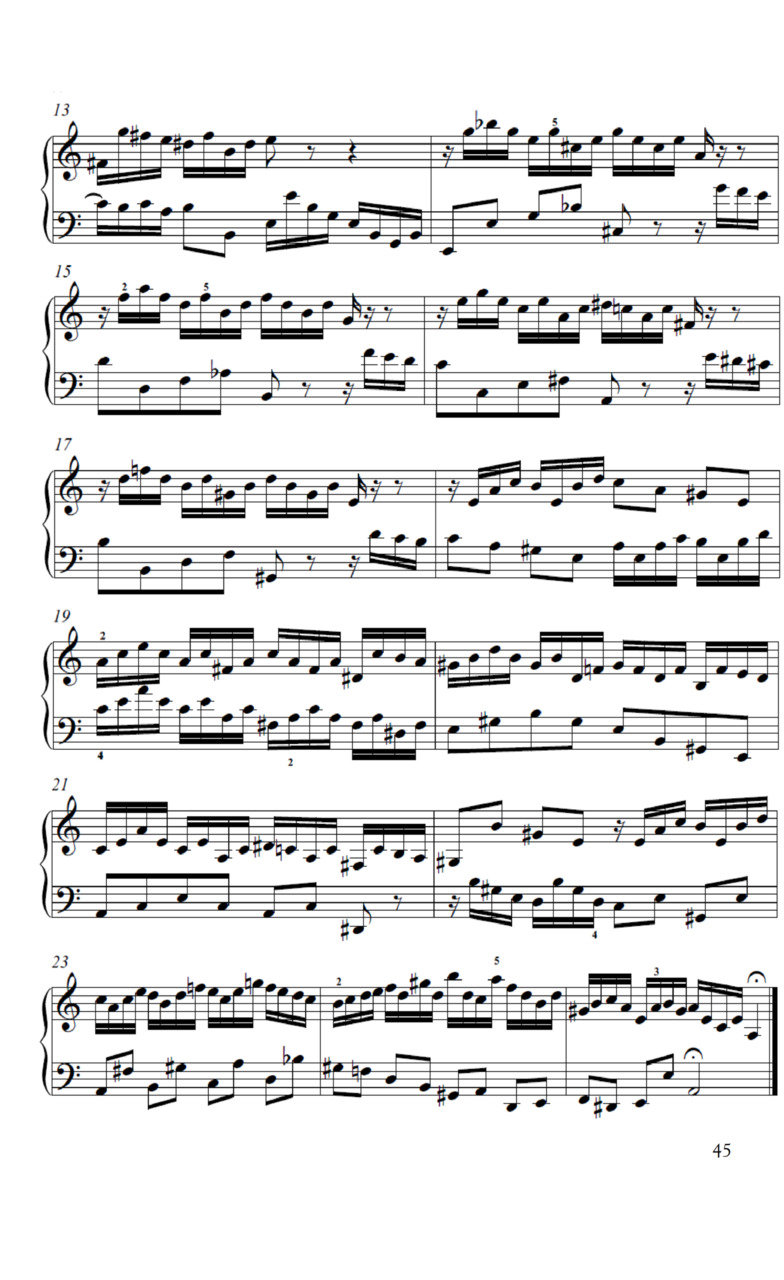
In large groups of the sixteenths, a different division is possible, for example
Bar 14:

The articulations are traditional. The eighths are performed non legato, the sixteenths are performed legato.
It is necessary to monitor carefully the segmentation of phrases where a new phrase begins on the second sixteenth with the introduction of the theme. For example, bar 2:
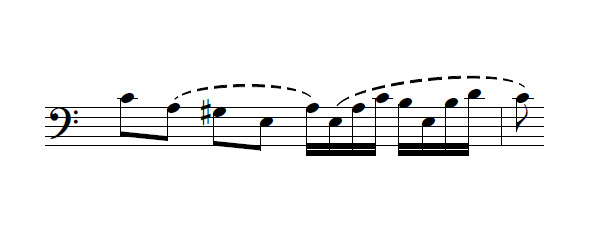
After sound «A», the beginning of a new phrase must be separated a little.
STAGE II
When one is working on the representation of vertical coincidence of the parts, starting with the pulsation in eighths and then moving on to the main pulsation of the composition in quarters, it is recommended to pay close attention to the slurred notes. These sounds must be mentally stretched to the next strong beat, and only after hearing how the sustained sound coincides with the sound of another part, you can play on.
When forming a holistic representation of a section (sentence), sounds form a hidden «part of the peaks» (in the first and second sections).
To preserve the timbre of each part throughout the entire invention, it is more convenient to make the right arm a supporting one.
STAGE III
When one gets to the third stage of the work, one should be well familiar with the text, even know it by heart. Without this, it is impossible to freely operate with sound representations and thus create an artistic image of the composition. It is imperative that one should work a lot without an instrument and without the text, mentally creating the integrity of the sound of each section and achieving a logical balance between the sections. The pace is determined basing on the integrity of the sentence, while the dynamics will reveal itself when the sections are combined. So, the second section will surely sound brighter than the first one, and in the third section (diminished chords) some disguise of sonority will be required, and the fourth section will become the culmination of the entire invention. It is better to pedal only the first beat and the third beat of a bar in accordance with the nature of the sound attack.
§5. INVENTION in B Minor, No. 15
PREPARATORY STAGE
The B minor invention is special: it seems to complete the cycle, there is wisdom and kindness in it. A light touch of a dance, slipping into the intonations of the theme, gives this invention a special charm.
The two sections of the invention contain a huge variety both in terms of intonation and in terms of articulation.
The general method of sound production is as follows: the palm is slightly stretched (to make the fingertips more sensitive), before the start of the movement, the fingers come into contact with the keys and set them in motion with a soft taking-to-oneself movement; the arms play with muscular support, preventing all the weight addition from passing into sound. The sound attack by pulsation (4/4 measure) should be softened and subtle.
STAGE I
The text of this invention requires the most serious study. Whimsicality and variability of the melody make you think literally at every bar.
Without analyzing each part, one can indicate the most significant points in the intonation structure.
The theme structure is as follows:

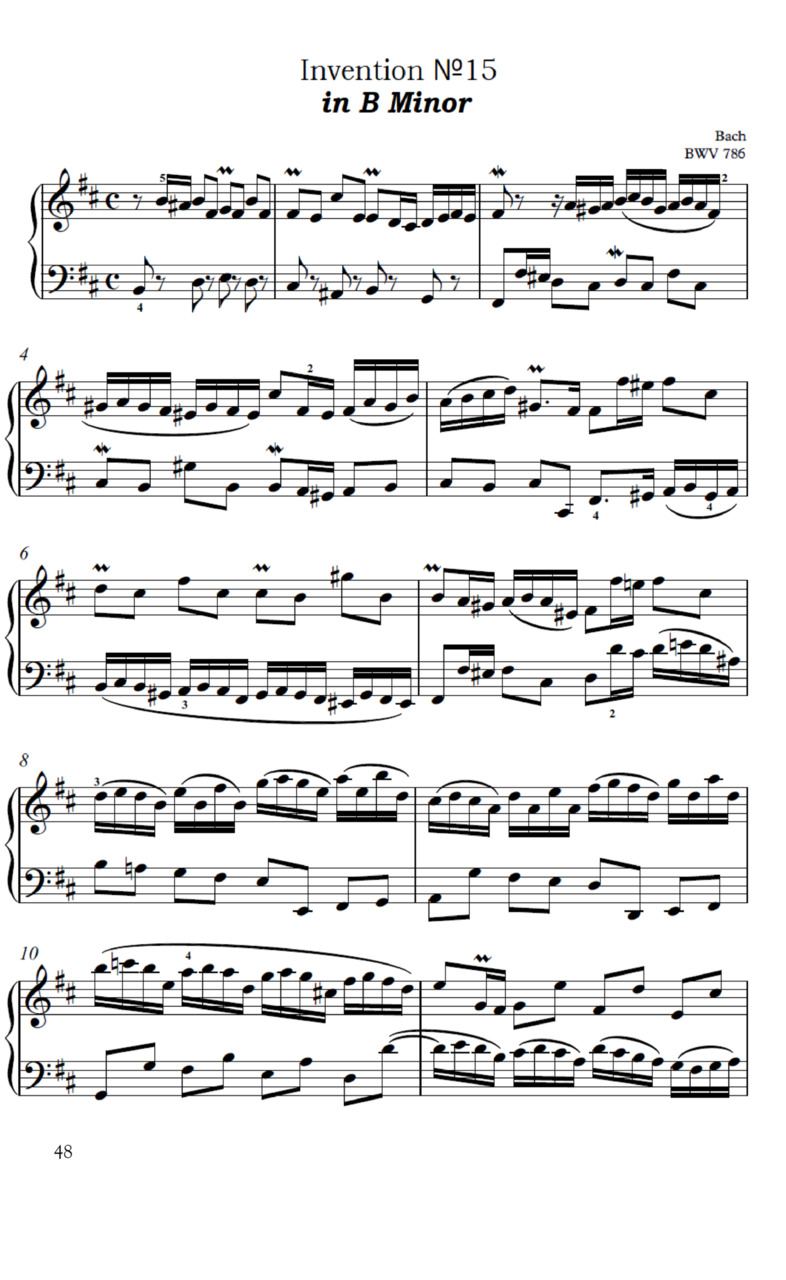
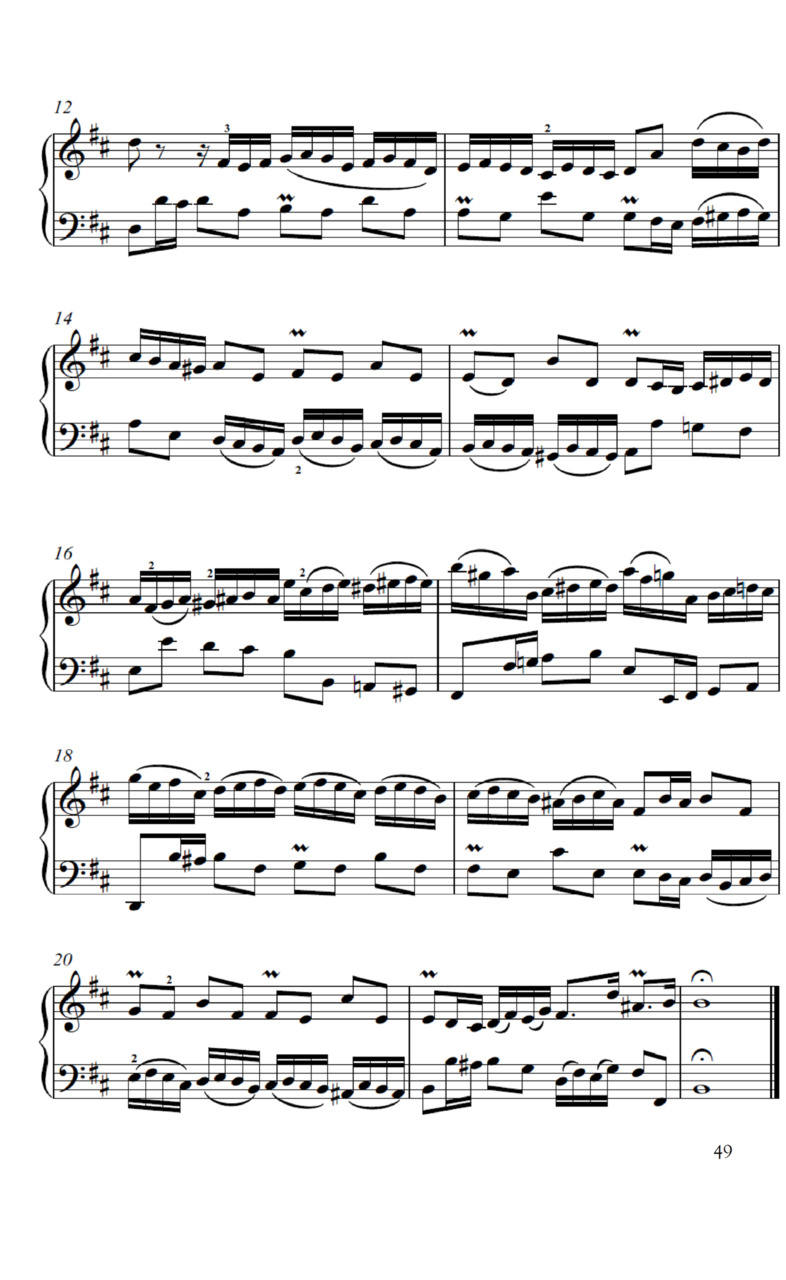
Which articulations to use while playing is a matter of the performer’s taste. There should be a difference in the articulation of the eighths and the sixteenths (perhaps the eighths will not be slurred). In addition, the hidden part should also differ (one should pay attention to lone «H» and «C-sharp»).
Mordents can be played starting not with the main sound, but with the upper one, this will give the theme more grace. The invention abounds in author’s slurs. Following the exact performing of the articulations creates a very special effect. Two identical components of the sequence will sound different if you follow Bach’s instructions in bars 8 and 9:

Even dynamically, a different performance of bars is required. An amazing example of the articulation of the climax is presented in bars 15—18. Small slurs at the end of the invention indicate the need to slow down the pace by switching to pulsation in eighths.
STAGES II AND III
There are no specific difficulties in this invention. If each part is carefully listened to and understood, if a vertical coincidence of the parts is heard by pulsation while maintaining the timbre colour and articulation distinction of each part, then the form of the section will be built naturally. Sentences or complete phrases different in length can be considered a peculiarity of the structure of the invention.
In the first section, such caesura will be at the beginning of the third bar, then in the fifth bar, then in the seventh bar and in the twelfth bar. In the second section, there will be hardly any conspicuous caesurae at all, since the beginning of a new phrase in bar 14 seems to follow from the previous passage in sixteenths, and the introduction of the theme in bar 18 occurs with the continuous sounding of the upper part.
It is very important to feel the right pace in this invention. Too fast a tempo can make it sound frivolous, and too slow a tempo can take away the charm of the ease of this invention. One can use the pedal every quarter note, but do it briefly.
Section 3. INVENTIONS WITH DANCE FEATURES IN THE CHARACTER OF PERFORMANCE
This group of inventions includes the following: D major, E major, E minor, G major and B-flat major.
§1. INVENTION in D Major, No. 3
PREPARATORY STAGE
The dances in this invention are rather rustic, spontaneous, rather than refined, with somewhat angular «stomping» across an octave.
For this «clumsiness» of unpretentious dance not to turn into primitiveness, one should nevertheless soften the first beat of each bar. To do this, the finger should «take» the key «to oneself». In addition, one should feel the pulsation in the arm (it is for this that the slurs are marked, where the first sound in a bar is taken separately non legato).
There are three sections of the invention. The first section is the shortest one. It is only one sentence long (ends at bar 12). The second section consists of three sentences (bars 24, 38, 42). The third section begins with an imperceptible appearance of a theme from a chain of the sixteenths. It is larger than the first section due to the development at the end.
STAGE I
The intonation of the theme develops throughout the entire invention. Phrases usually consist of several motives; the main motives are as follows:
Bars 1—4
Бесплатный фрагмент закончился.
Купите книгу, чтобы продолжить чтение.